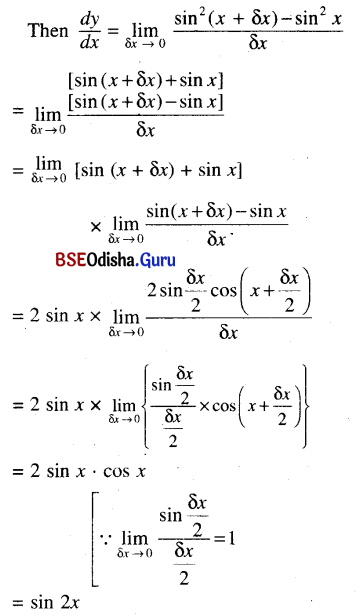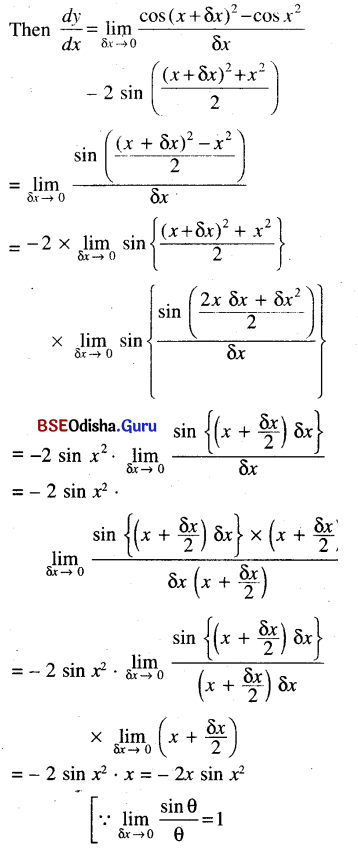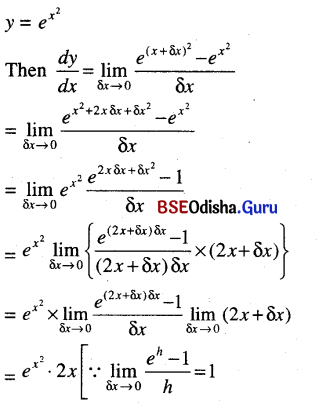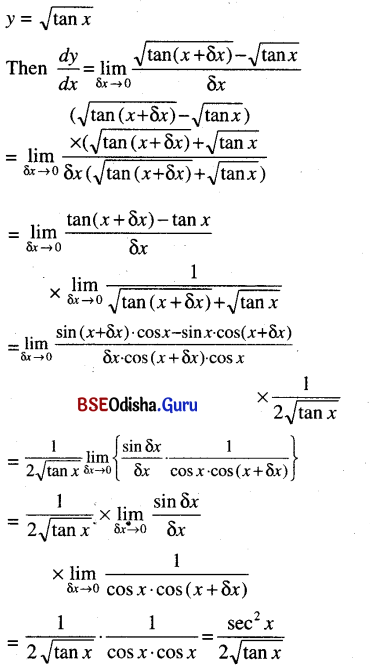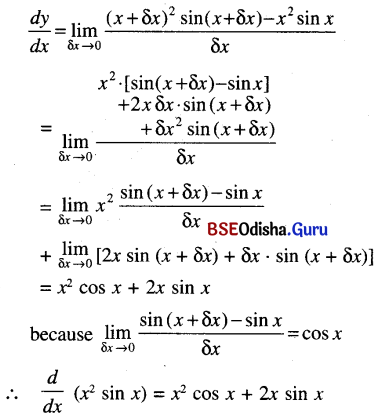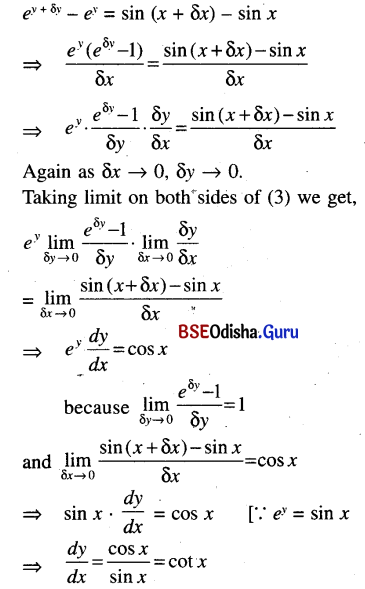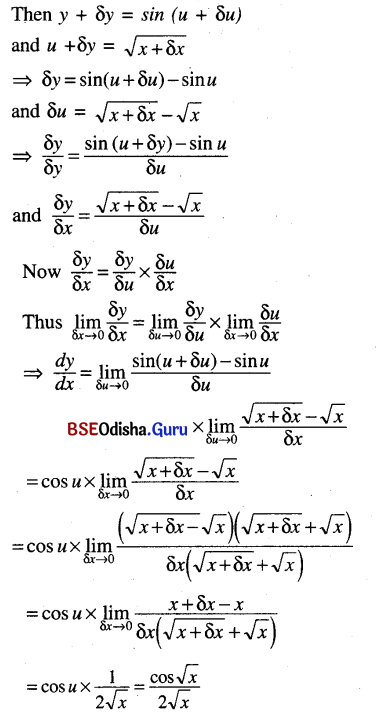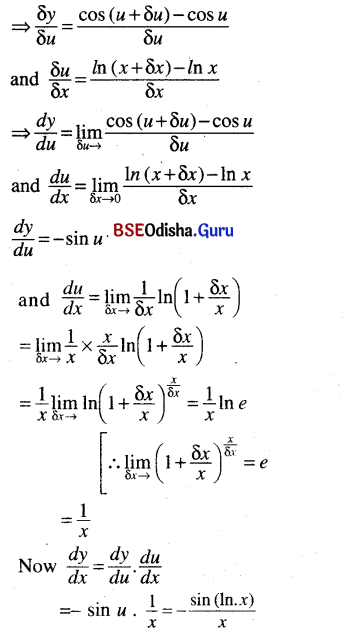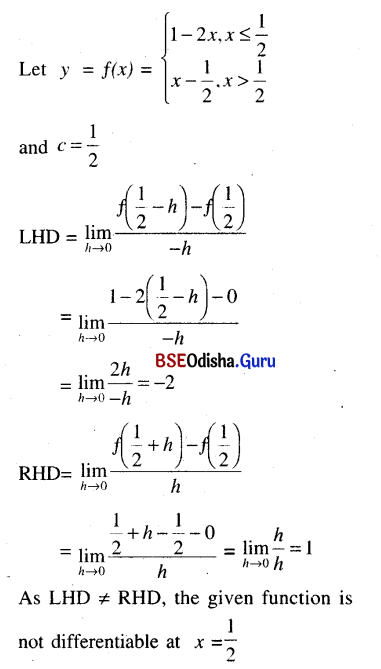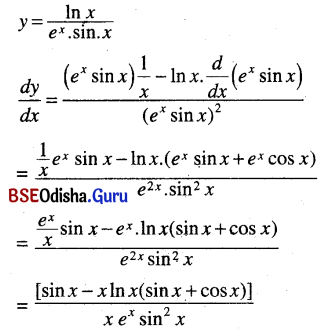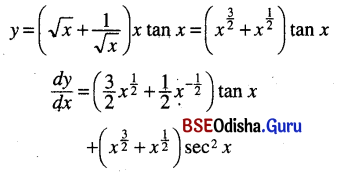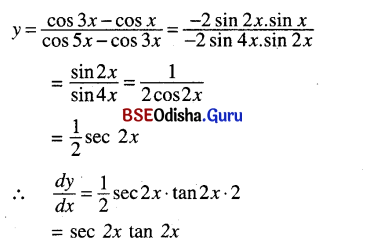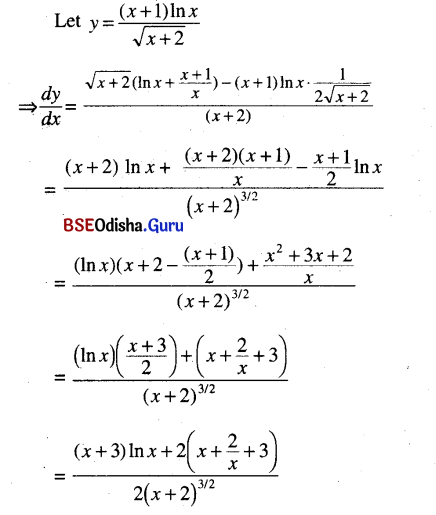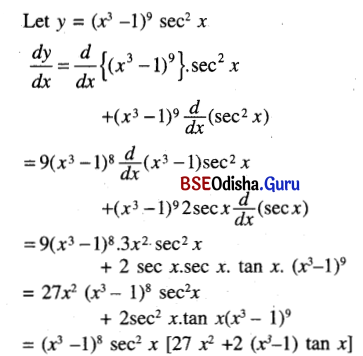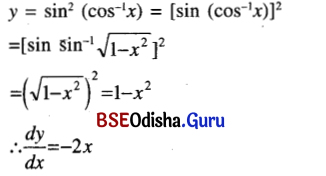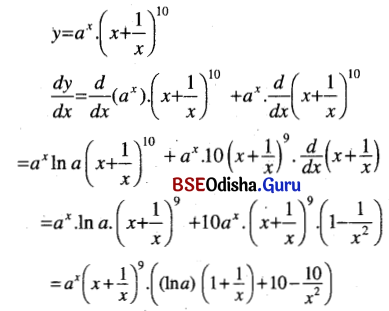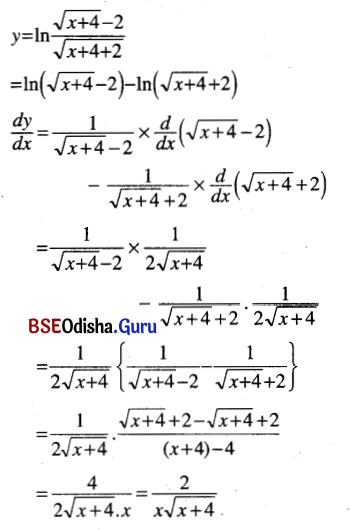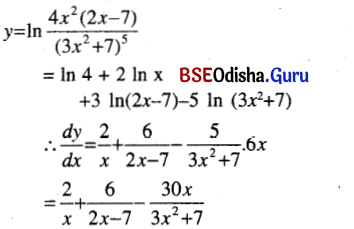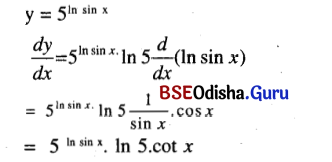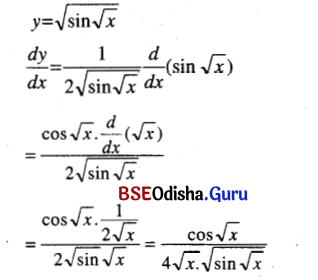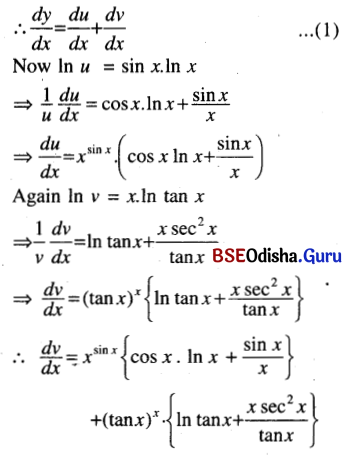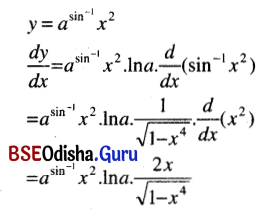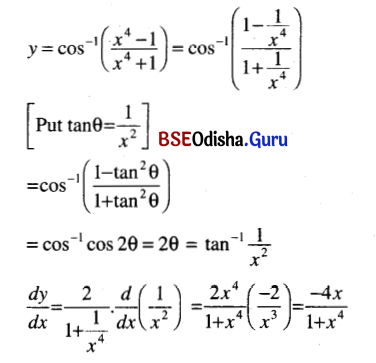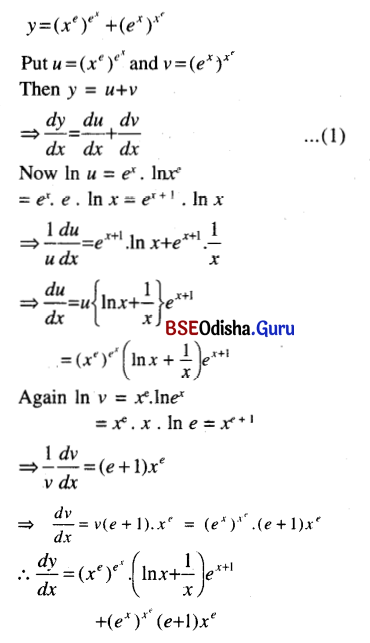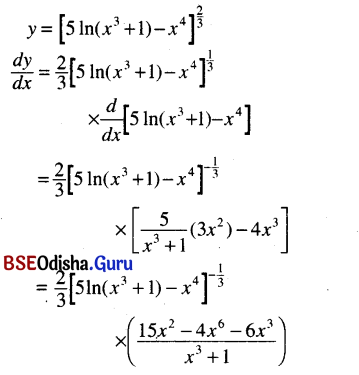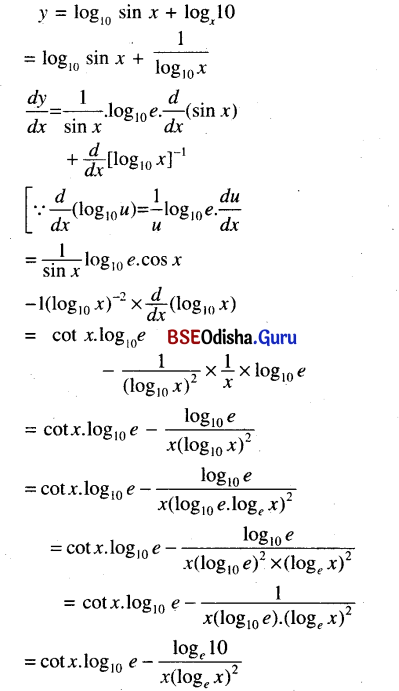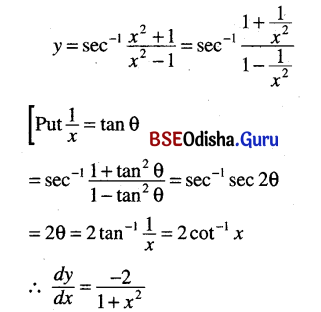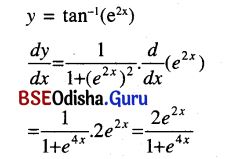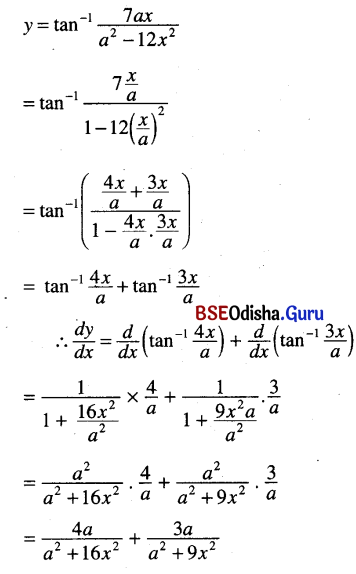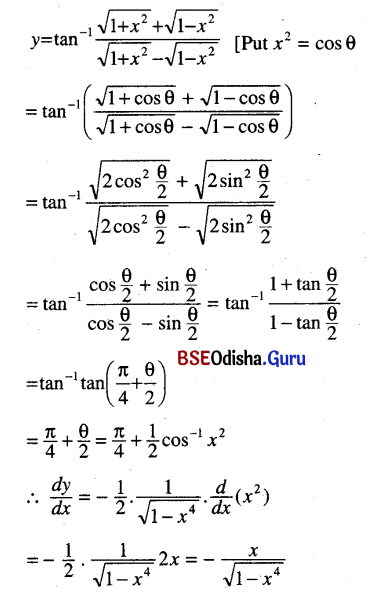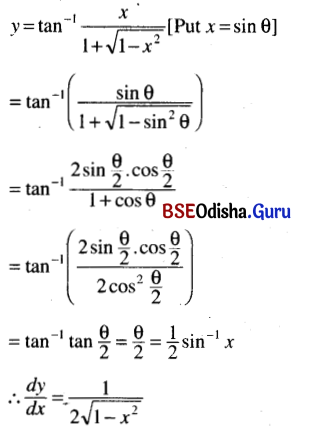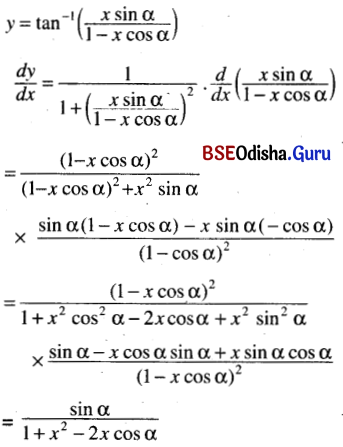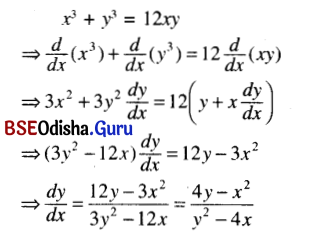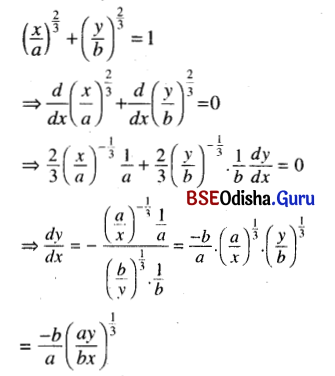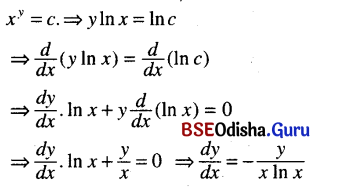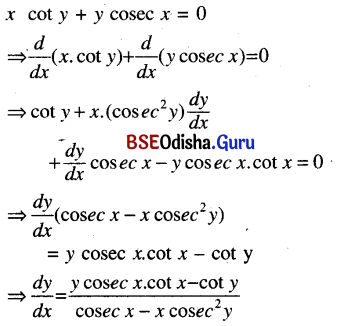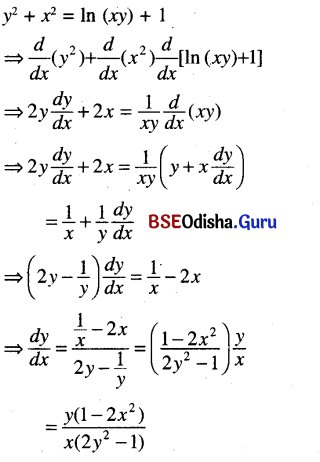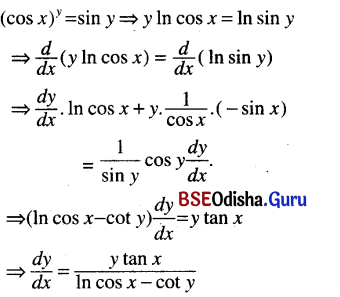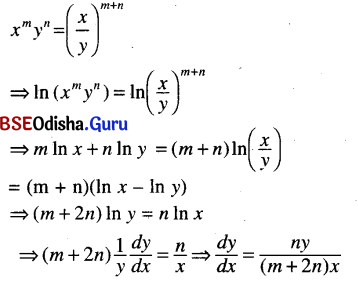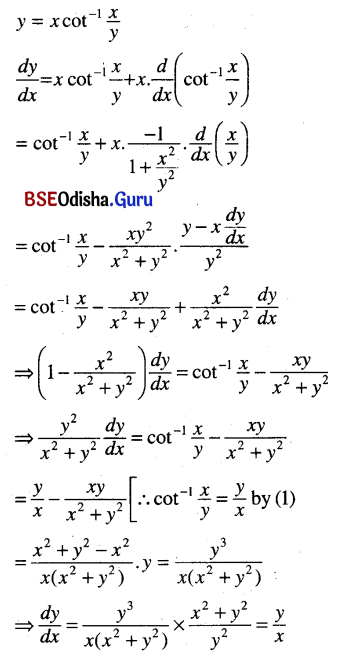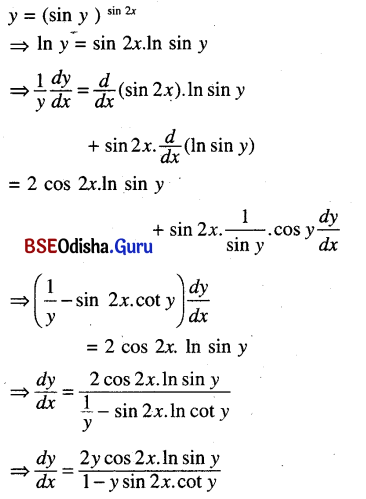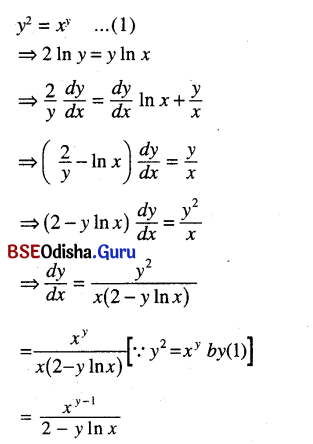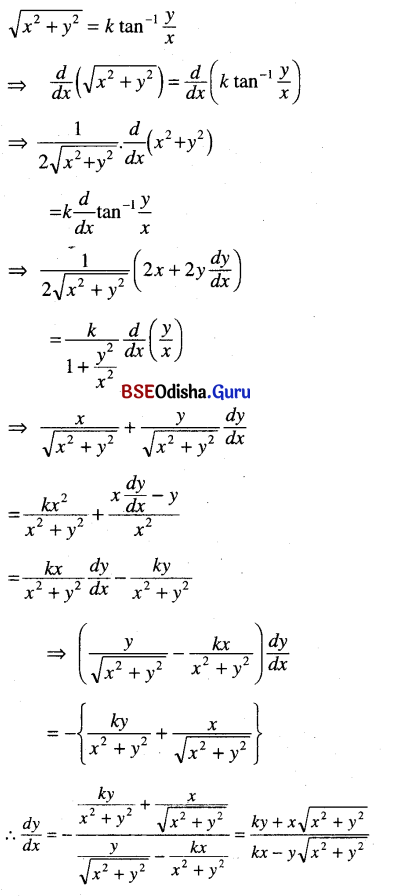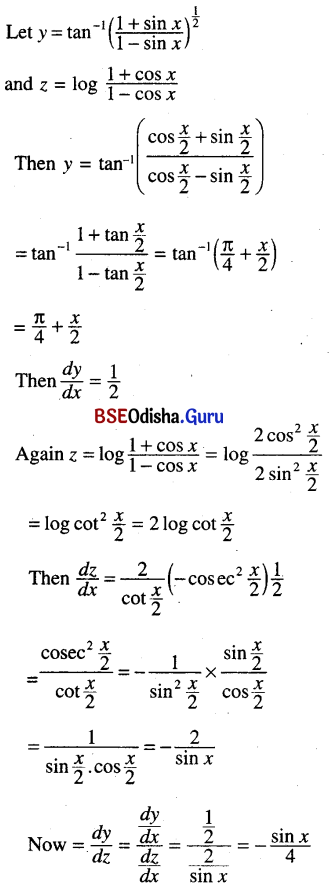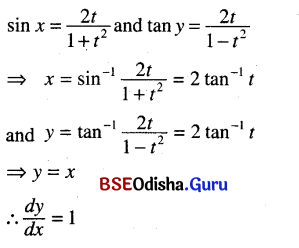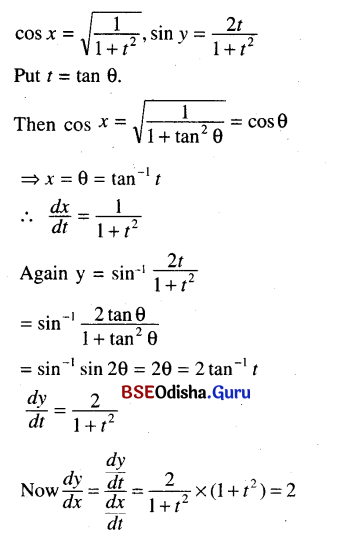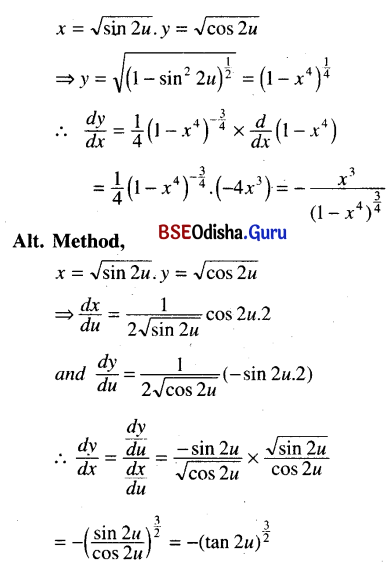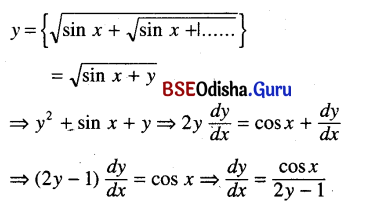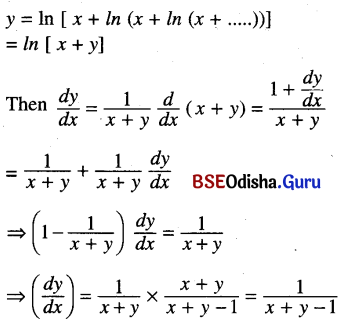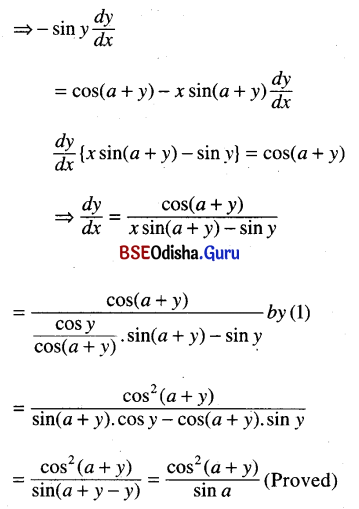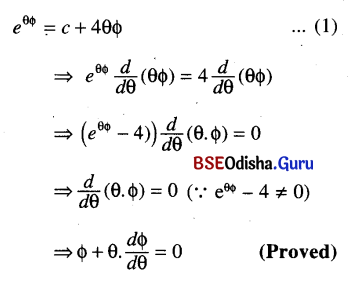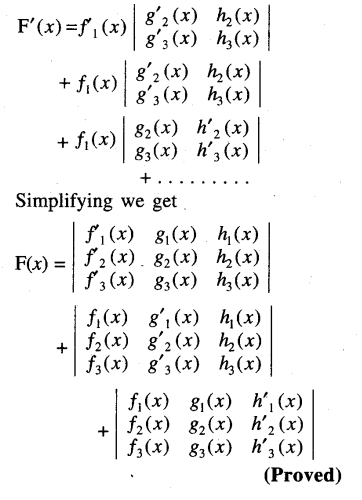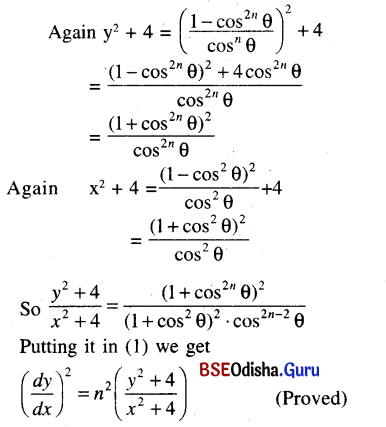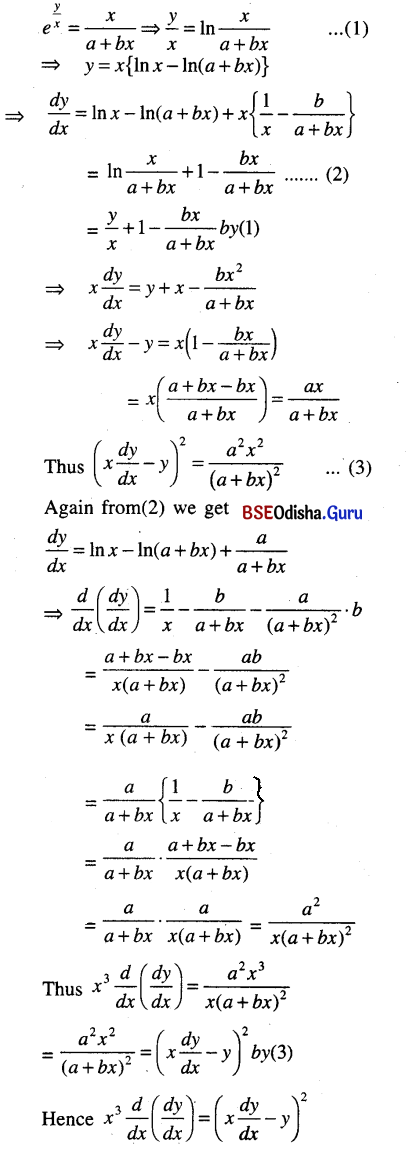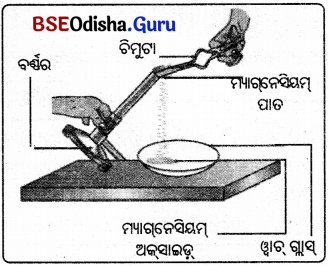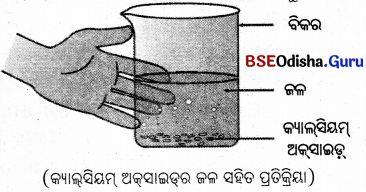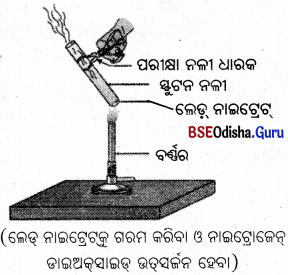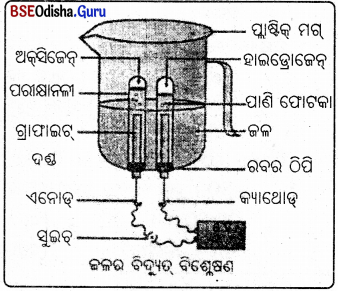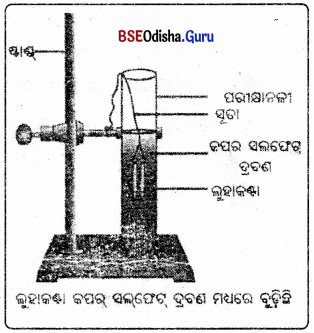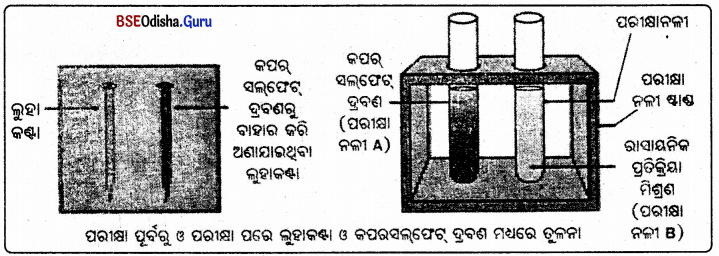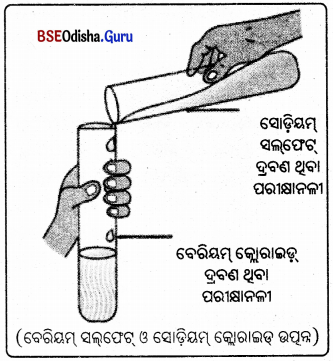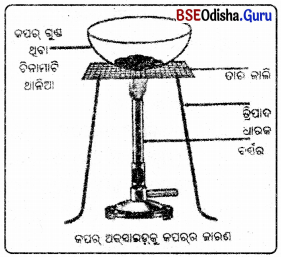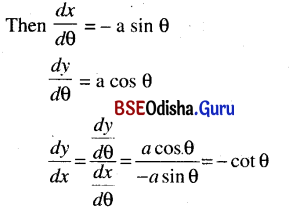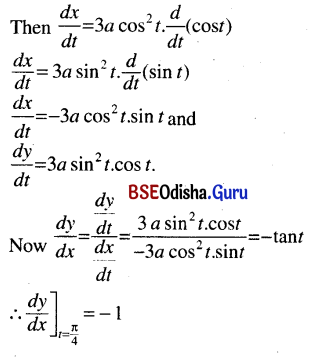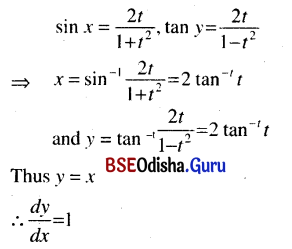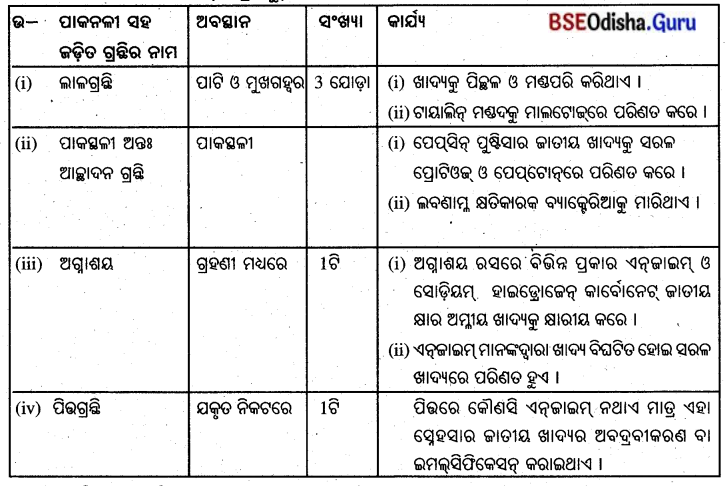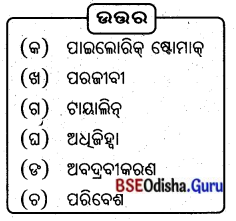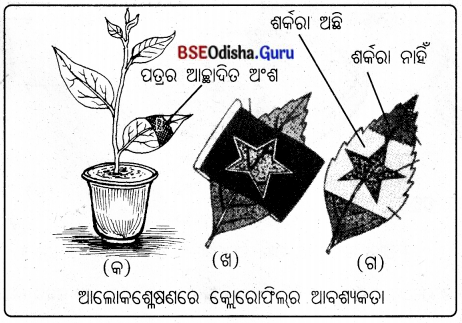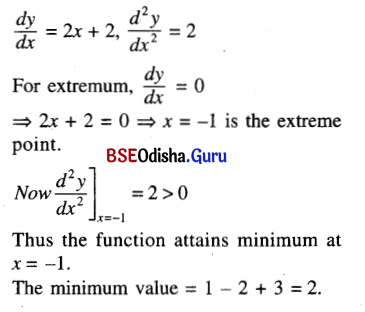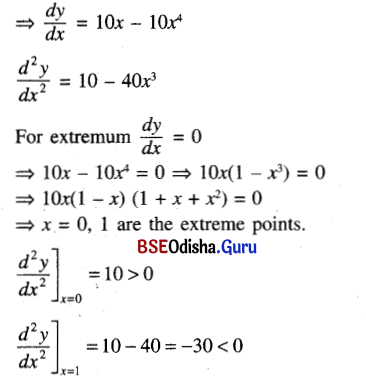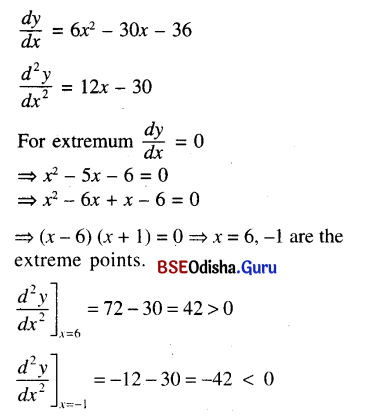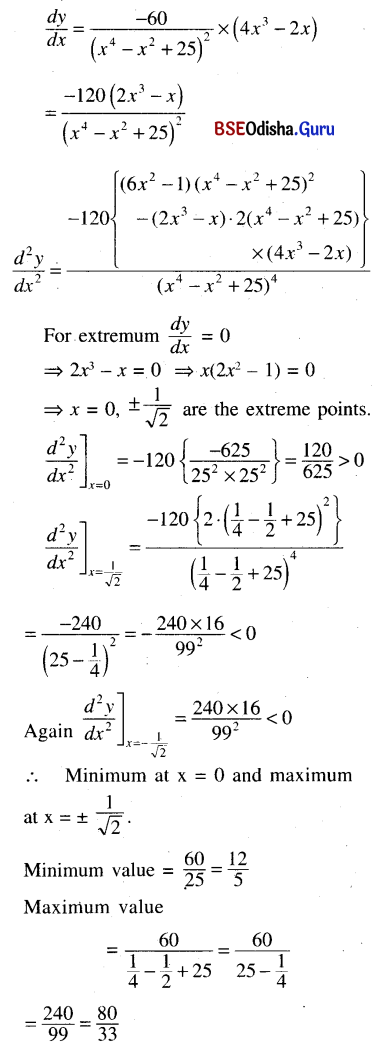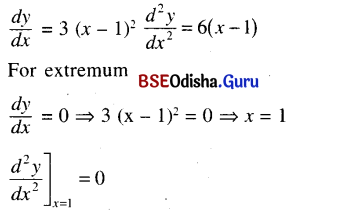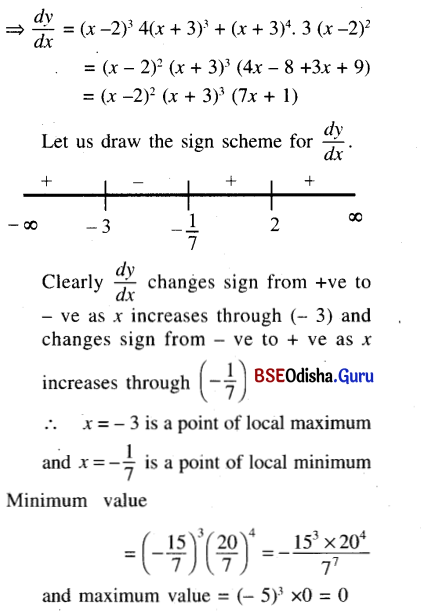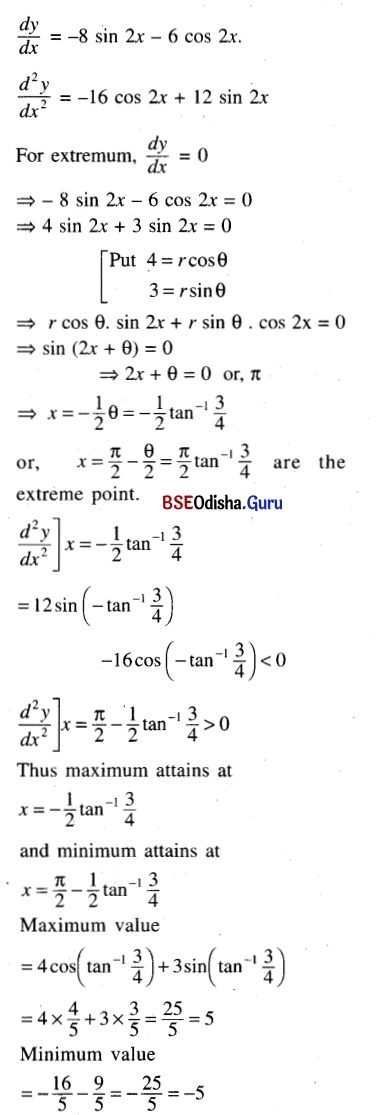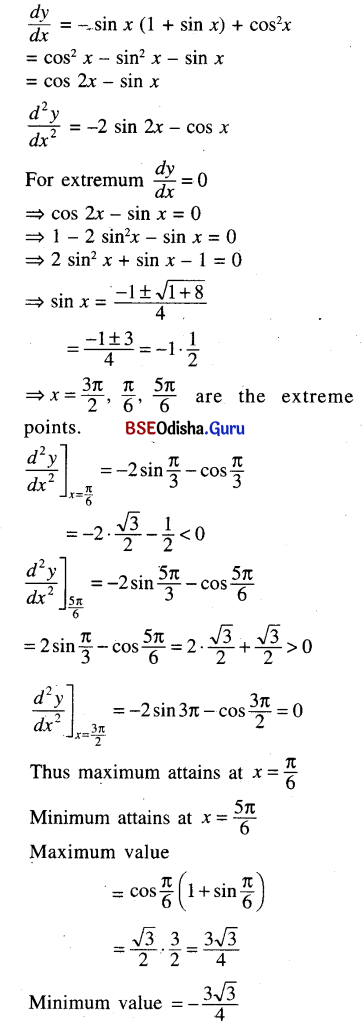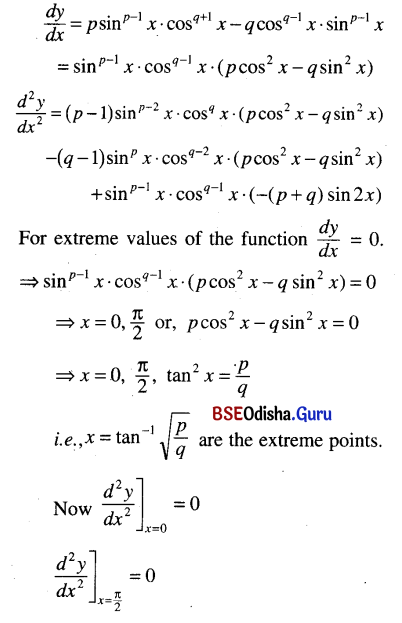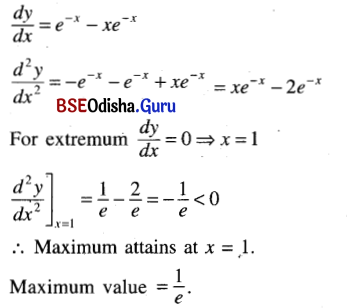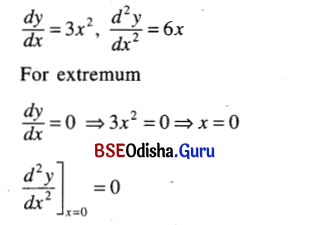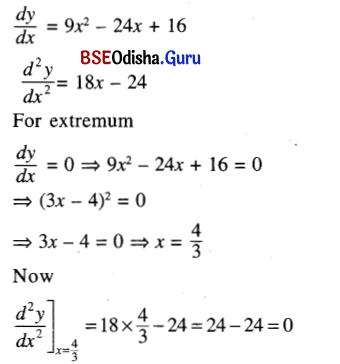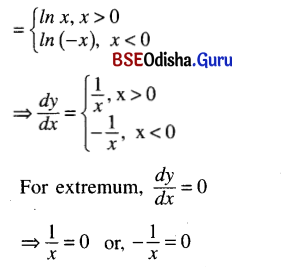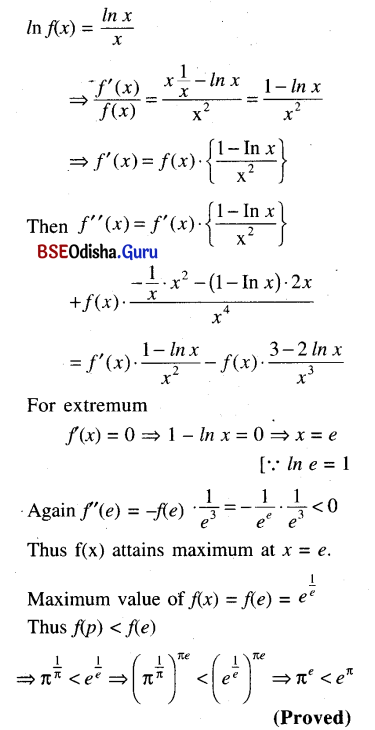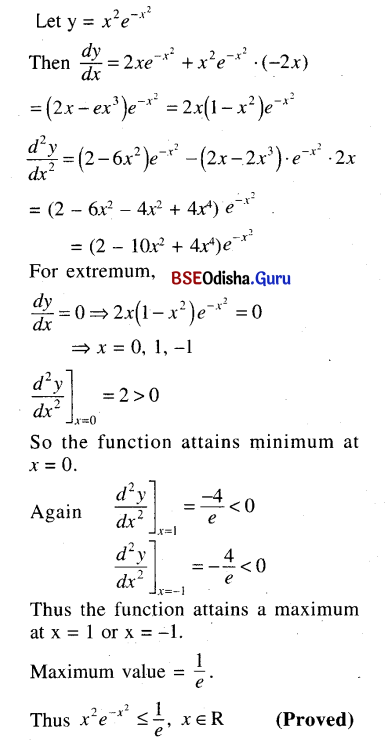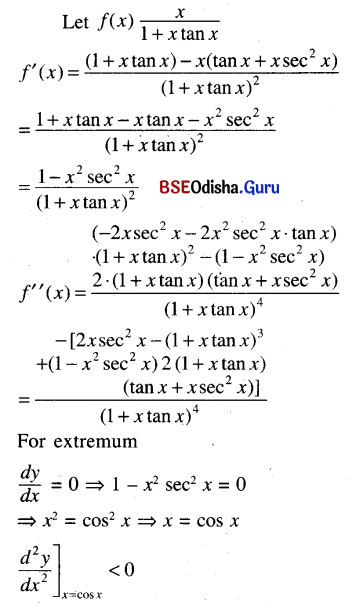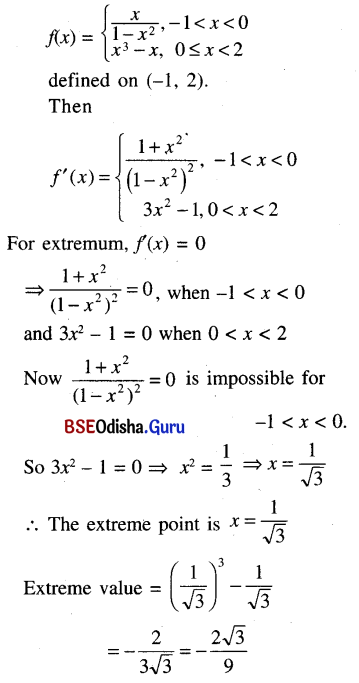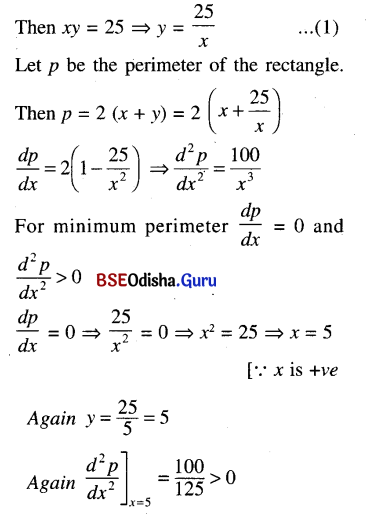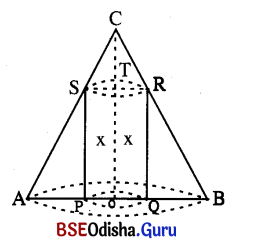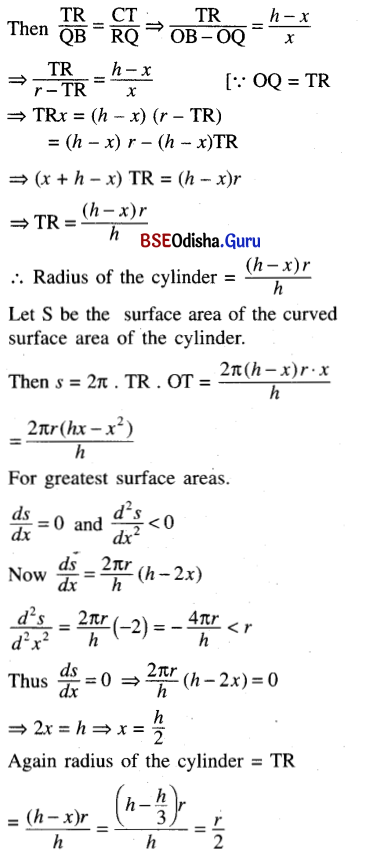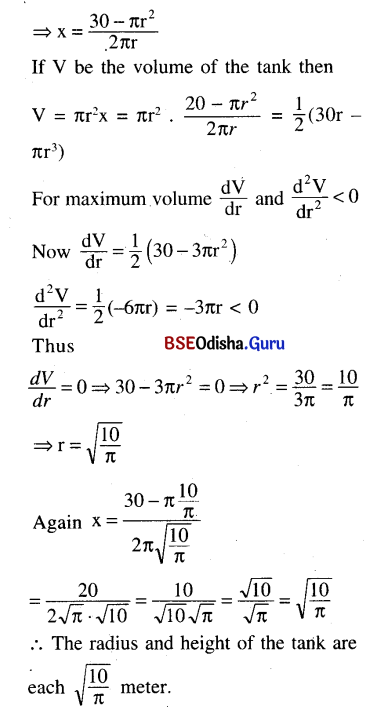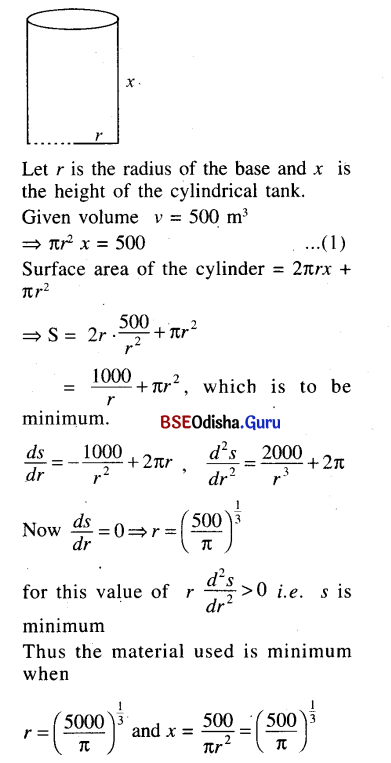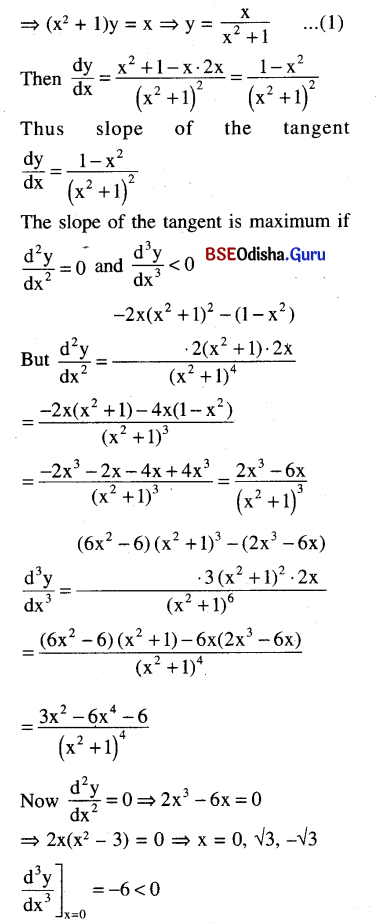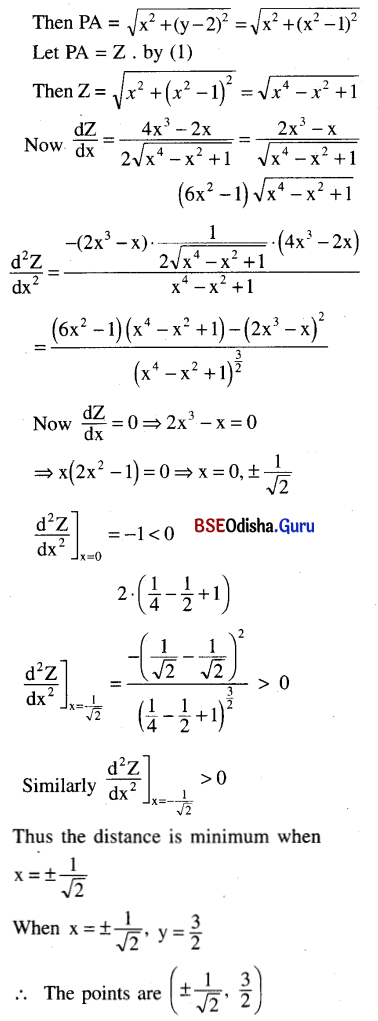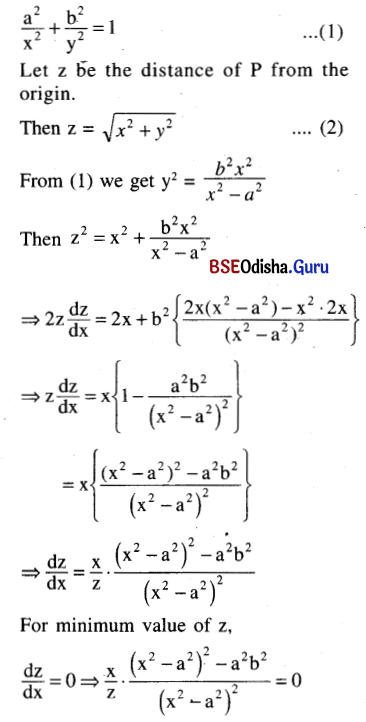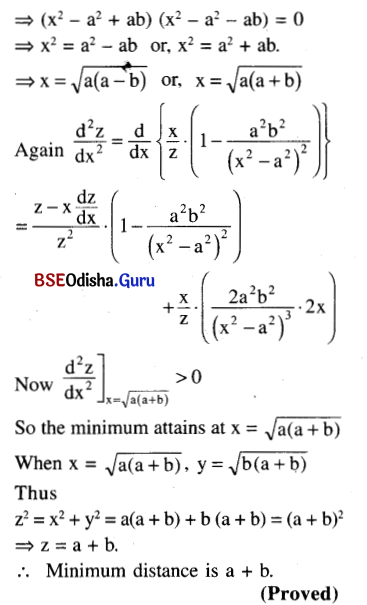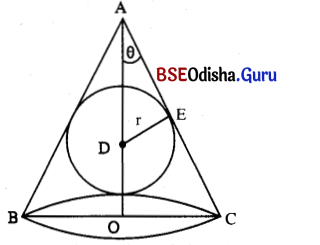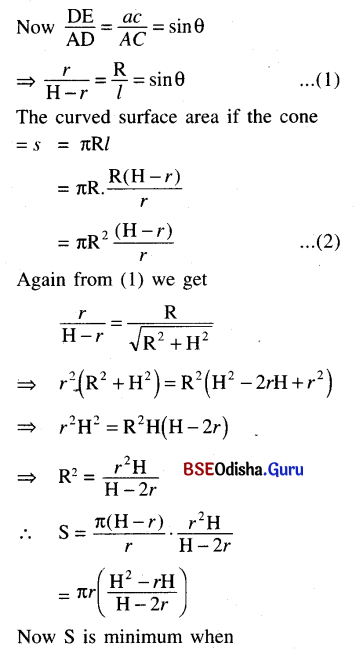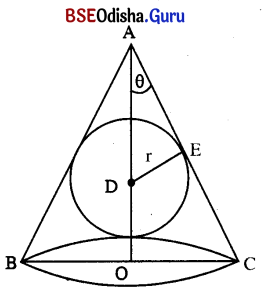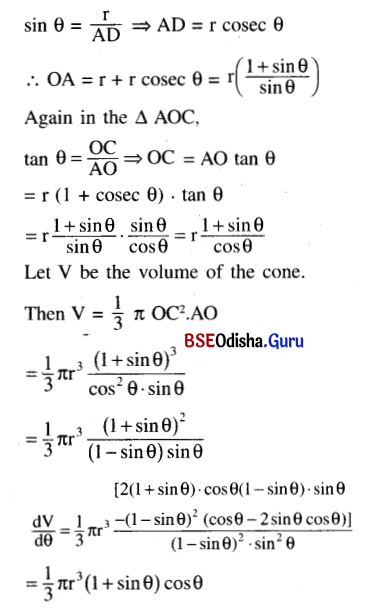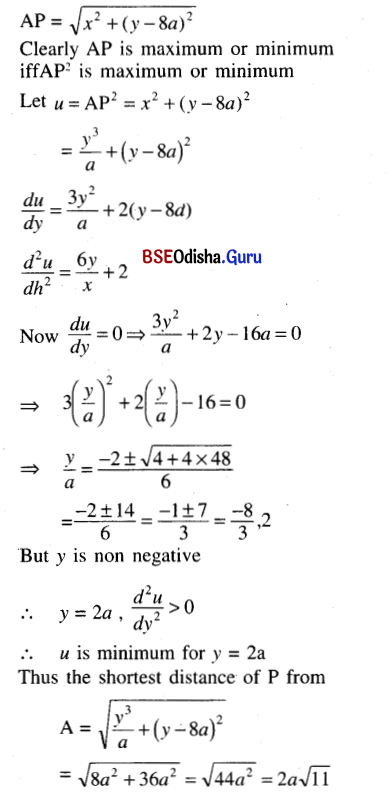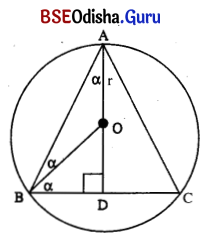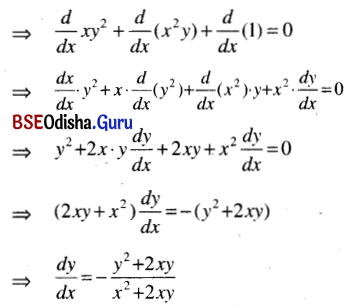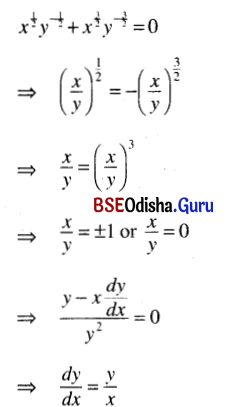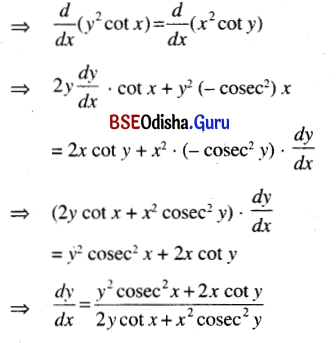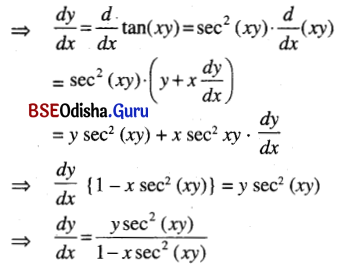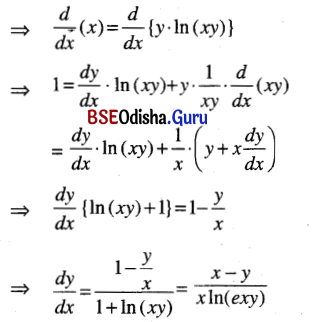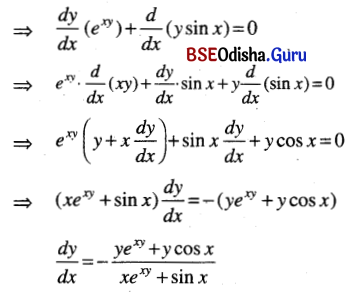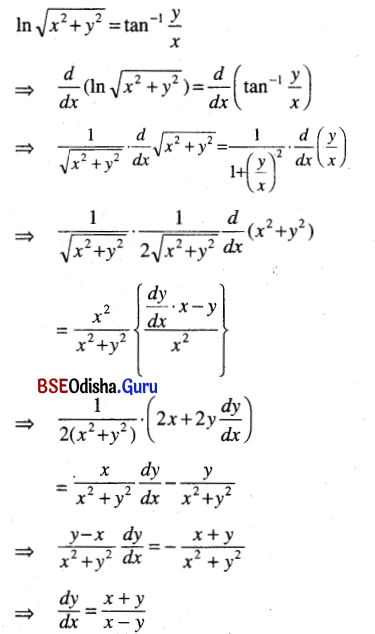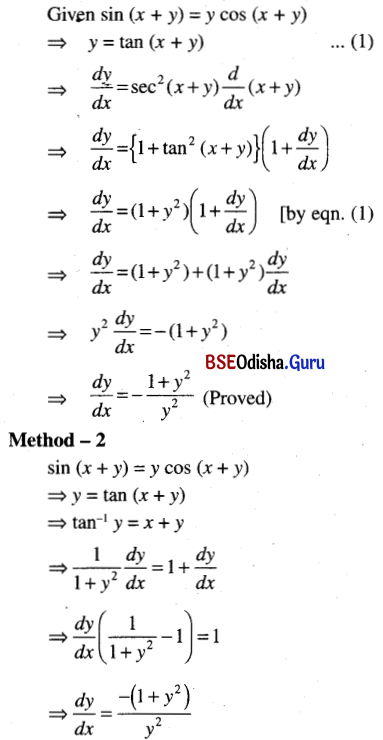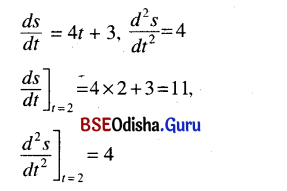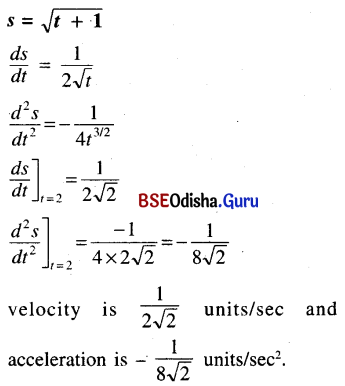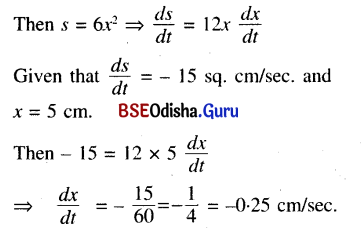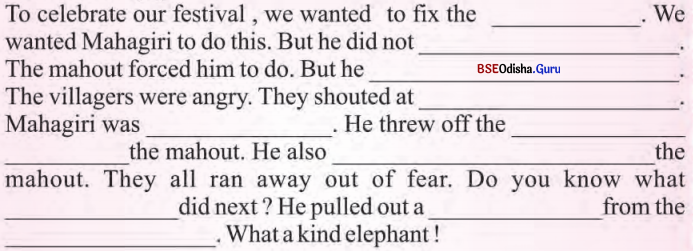Odisha State Board BSE Odisha 10th Class Life Science Notes Chapter 2 ଶ୍ବସନ will enable students to study smartly.
BSE Odisha Class 10 Life Science Notes Chapter 2 ଶ୍ବସନ
प्रश्न और अभ्यास (ପ୍ରଶ୍ନ ଔର୍ ଅଭ୍ୟାସ)
→ଉପକ୍ରମ (Introduction) :
ଜୀବକୋଷରେ ଖାଦ୍ୟର ଜାରଣ ହୋଇ ସେଥୁ ଶକ୍ତି ନିର୍ଗତ ହୁଏ । ଶରୀରର ବିଭିନ୍ନ ପ୍ରକ୍ରିୟା ଚାଲୁରଖିବା ପାଇଁ ଶକ୍ତି ଆବଶ୍ୟକ । ଯେଉଁ ପ୍ରଣାଳୀରେ ଖାଦ୍ୟରୁ ଶକ୍ତି ନିର୍ଗତ ହୁଏ, ତାହାକୁ ଶ୍ବସନ କୁହାଯାଏ ।
→ଶ୍ୱସନ (Respiration) :
- ଶ୍ୱସନ ପାଇଁ ଅମ୍ଳଜାନ ଆବଶ୍ୟକ । ବେଳେବେଳେ ଏହାର ଅନୁପସ୍ଥିତିରେ ମଧ୍ୟ ଶ୍ବସନ ଘଟିଥାଏ ।
- ଗ୍ଲା କୋଜ୍ ଏକ ଛଅ ଅଙ୍ଗାରକ ବିଶିଷ୍ଟ ଯୌଗିକ । ଏହାର ଗାଠନିକ ଅଣୁ ସଂକେତ C6H2O2 ଅଟେ ।
- ଅମ୍ଳଜାନ ଉପସ୍ଥିତିରେ ଗ୍ଲୁକୋଜ ଅଣୁ ଭାଙ୍ଗି ଅଙ୍ଗାରକାମ୍ଳ (CO2), ଜଳ (H2O) ଓ ଶକ୍ତି ଉତ୍ପନ୍ନ ହୋଇଥାଏ ।
- ଏହି ପ୍ରକ୍ରିୟାରୁ ଶକ୍ତି ମୋଚିତ ହୋଇଥାଏ । ଏହି କାରଣରୁ ଶ୍ବସନ ଏକ ଅପଚୟ ପ୍ରକ୍ରିୟା ଅଟେ ।
- କୋଷ ଜୀବକରେ ଗ୍ଲା କୋଜ ଅଣୁର ବିଘଟନ ଘଟି ପ୍ରଥମେ ଏହା ତିନି କାର୍ବନବିଶିଷ୍ଟ ଦୁଇଟି ପାଇରୁଭିକ୍ ଅମ୍ଳରେ ପରିଣତ ହୁଏ ଓ ଏହା ସବୁ ପ୍ରକାର ଶ୍ବସନର ପ୍ରଥମ ସୋପାନ ଅଟେ ।
- ଅମ୍ଳଜାନର ଉପସ୍ଥିତିରେ ପାଇରୁଭିକ୍ ଅମ୍ଳରୁ ଅଙ୍ଗାରକାମ୍ଳ ଓ ଜଳ ସହ ଶକ୍ତି ସୃଷ୍ଟି ହୁଏ ।
- ଅମ୍ଳଜାନର ଅନୁପସ୍ଥିତିରେ ବା ଅଭାବରେ ଏଥୁରୁ ଅନ୍ୟ ଉତ୍ପାଦ ସହ ଶକ୍ତି ମଧ୍ୟ ସୃଷ୍ଟି ହୋଇଥାଏ ।
→ଶ୍ଵାସନର ପ୍ରକାରଭେଦ (Types of Respiration) :
1.ଶ୍ଵାସନରେ ଗ୍ଲୁକୋଜ ଭଳି ସରଳ ଖାଦ୍ୟ ଜାରିତ ହୋଇ ବ୍ୟବହାରକ୍ଷମ ଶକ୍ତି ATP ହେବା ସହିତ ଅଙ୍ଗାରକାମ୍ଳ ନିର୍ଗତ ହୁଏ ।
2.ଶ୍ଵାସନ ଦୁଇ ପ୍ରକାରର; ଯଥା-
(a) ବାୟୁ ଉପଜୀବୀ ଶ୍ୱସନ (Aerobic Respiration)
(b) ବାୟୁ ଅପଜୀବୀ ଶ୍ୱସନ (Anaerobic Respiration)
ଅମ୍ଳଜାନ ଉପସ୍ଥିତିରେ ହେଉଥିବା ଶ୍ୱସନକୁ ବାୟୁ ଉପଜୀବୀ ଶ୍ୱସନ ଓ ଅମ୍ଳଜାନ ଅନୁପସ୍ଥିତିରେ ହେଉଥିବା ଶ୍ବସନକୁ ବାୟୁ ଅପଜୀବୀ ଶ୍ଵାସନ କୁହାଯାଏ ।
3.ବାୟୁ ଉପଜୀବୀ ଶ୍ଵାସନରେ ଅଧ୍ଵକ ଶକ୍ତି ମିଳୁଥିବାବେଳେ ବାୟୁ ଅପଜୀବୀ ଶ୍ଵାସନରେ କମ୍ ଶକ୍ତି ମିଳିଥାଏ
![]()
→କୋଷୀୟ ଶ୍ବସନ :
1. ଖାଦ୍ୟର ଜାରଣ, ଶକ୍ତିମୋଚନ ଓ ଅଙ୍ଗାରକାମ୍ଳ ଗ୍ୟାସ୍ ନିର୍ଗମନ ପ୍ରକୃତପକ୍ଷେ କୋଷରେ ସଧୂ ହୁଏ । କୋଷୀୟ ଶ୍ୱସନ ପାଇଁ ମୁଖ୍ୟ ଆଧାର ରସାୟନ ରୂପେ -କାର୍ବନଯୁକ୍ତ ଗ୍ଲୁକୋଜ ଅଣୁକୁ ବିବେଚନା କରାଯାଇଥାଏ । ଅମ୍ଳଜାନ ଉପସ୍ଥିତିରେ ଗ୍ଲୁକୋଜ ଜାରଣଦ୍ବାରା ଅଙ୍ଗାରକାମ୍ଳ ନିର୍ଗତ ହେବା ସହିତ ଅଧିକ ଶକ୍ତିଯୁକ୍ତ ବିଜାରିତ ଅଣୁ ଓ ଶକ୍ତି ମୁଦ୍ରା ତିଆରି ହୁଏ ।
![]()
2. କୋଷୀୟ ଶ୍ୱସନ ତିନି ପର୍ଯ୍ୟାୟରେ ଘଟିଥାଏ । ସେଗୁଡ଼ିକ ହେଲା : ଗ୍ଲାଇକୋଲିସିସ୍ (Glycolysis), ସାଇଟ୍ରିକ୍ (Cytric Acid Cycle) 3 6mg? Aña?? °| (Electron Transport System) 1.
→କୋଷୀୟ ଶ୍ୱସନ ଆଧାର :
- କୋଷ ଭିତରେ କୋଷଜୀବକ ଥାଏ ଓ ଏହା କୋଷଝିଲ୍ଲୀଦ୍ଵାରା ଆବୃତ ହୋଇଥାଏ ।
- କୋଷଜୀବକରେ ବିଭିନ୍ନ ଅଙ୍ଗିକା, ଏନ୍ଜାଇମ୍, ପୋଷକ ଅଣୁ ଇତ୍ୟାଦି ଥାଏ ଓ ଏଥିରେ ଗ୍ଲାଇକୋଲିସିସ୍ ପ୍ରକ୍ରିୟା ସମ୍ପାଦିତ ହୁଏ । ମାଇଟୋକଣ୍ଡ୍ରିଆ ଅଙ୍ଗିକା ଦ୍ବିସ୍ତରୀୟ ଝିଲ୍ଲୀଦ୍ଵାରା ଆବୃତ । ଏହା ଭିତରେ ଥିବା ରସପୂର୍ଣ୍ଣ ଅଂଶକୁ ମାଟ୍ରିକ୍ସ କୁହାଯାଏ ।
- ବିଭିନ୍ନ ଜୈବିକ ଅମ୍ଳ, ଏନ୍ଜାଇମ୍, ଲିପିଡ୍, ପ୍ରୋଟିନ୍ ଅଣୁ ଇତ୍ୟାଦି ଥାଏ । ଦ୍ବିସ୍ତରୀୟ ଝିଲ୍ଲୀର ଅନ୍ତଃଝିଲ୍ଲୀ ମାଟ୍ରିକ୍ସ ଭିତରକୁ ଭାଙ୍ଗ ହୋଇ ପଶି ଆସିଥାଏ । ଏଭଳି ଭାଙ୍ଗକୁ କ୍ରିଷ୍ଟି (Cristae) କୁହାଯାଏ ।
→ଗ୍ଲାଇକୋଲିସିସ୍ | (Glycolysis) :
- କୋଷର କୋଷଜୀବକରେ ଗ୍ଲାଇକୋଲିସିସ୍ ପ୍ରକ୍ରିୟା ହୁଏ । ଏହି ପ୍ରକ୍ରିୟାରେ ଗ୍ଲୁକୋଜର ବିଘଟନ ଦୁଇଟି ସୋପାନରେ ହୋଇଥାଏ ।
- ପ୍ରଥମ ସୋପାନରେ 6- କାର୍ବନଯୁକ୍ତ ଗୁକୋଜ ଅଣୁ ଏଟିପି ଗ୍ରହଣ କରି ଉଦ୍ଦୀପିତ ହେବାଦ୍ଵାରା ଦୁଇଟି 3- କାର୍ବନଯୁକ୍ତ ସରଳ ଶର୍କରାରେ ବିଭକ୍ତ ହୁଏ ।
- ଦ୍ଵିତୀୟ ସୋପାନରେ ପ୍ରତି 3- କାର୍ବନଯୁକ୍ତ ଶର୍କରା ଜୈବ ରାସାୟନିକ କ୍ରିୟାଦ୍ଵାରା ପାଇରୁଭିକ୍ ଅମ୍ଳ ନାମିତ ଏକ 3- କାର୍ବନଯୁକ୍ତ ଜୈବିକ ଅମ୍ଳରେ ପରିଣତ ହୁଏ ।
- ଏହି ସୋପାନରେ ଶକ୍ତି ମୁଦ୍ରା ATP ଏବଂ ଶକ୍ତିସମ୍ପନ୍ନ ବିଜାରିତ ସହକାରକ ନିକୋଟିମାଇଡ୍ ଏଡ଼େନାଇନ୍ ଡାଇନ୍ୟୁକ୍ଲିଟୋଇଡ୍ ବା NADH2 ଉତ୍ପନ୍ନ ହୁଏ ।
![]()
- କୋଷ ପରିବେଶରେ ଅମ୍ଳଜାନର ମାତ୍ରା ଅନୁଯାୟୀ ପାଇରୁଭିକ୍ ଅମ୍ଳ ବିଭିନ୍ନ ଜୈବିକ କ୍ରିୟା ମାଧ୍ୟମରେ ପରିଚାଳିତ ହୋଇଥାଏ ।
- ଅମ୍ଳଜାନ ଅନୁପସ୍ଥିତିରେ ଇଷ୍ଟ ଭଳି ଅଣୁଜୀବ କୋଷରେ ପାଇରୁଭିକ୍ ଅମ୍ଳ 2-କାର୍ବନଯୁକ୍ତ ଇଥାନଲ୍ ବା ସୁରାସାରରେ ପରିଣତ ହୁଏ । ଏହି କ୍ରିୟାରେ ଏକ ଅଙ୍ଗାରକାମ୍ଳ ଓ ଅଳ୍ପ ଶକ୍ତି ନିର୍ଗତ ହୁଏ । ଏହାକୁ ମଧ୍ୟ ସୁରାସାର କିଣ୍ବନ କୁହାଯାଏ ।
- ଅମ୍ଳଜାନ ଅଭାବରେ ପାଇରୁଭିକ୍ ଅମ୍ଳ 3-କାର୍ବନଯୁକ୍ତ ଲାକଟିକ୍ ଅମ୍ଳରେ ପରିଣତ ହୁଏ । ଏହା ପେଶୀ କୋଷରେ ଘଟିଥାଏ । ଫଳରେ ସମୟ ସମୟରେ ମାଂସପେଶୀ ସଂକୋଚନ ହୋଇଯାଏ ।
- ଅମ୍ଳଜାନ ଉପସ୍ଥିତିରେ ପାଇରୁଭିକ୍ ଅମ୍ଳ ମାଇଟୋକଣ୍ଡ୍ରିଆକୁ ପ୍ରବେଶ କରେ ଓ ବିଭିନ୍ନ ଜୈବ ରାସାୟନିକ କ୍ରିୟା ମାଧ୍ୟମରେ ଶକ୍ତି ମୁକ୍ତ ହେବା ସହିତ ଅଙ୍ଗାରକାମ୍ଳ ଓ ଜଳ ନିର୍ଗତ କରିଥାଏ । ଏହାକୁ ବାୟୁ ଉପଜୀବୀ ଶ୍ଵାସନ କୁହାଯାଏ ।
→ସାଇଟ୍ରିକ୍ ଏସିଡ୍ ଚକ୍ର | (Citric acid cycle) :
1.ମାଇଟୋକଣ୍ଡ୍ରିଆର ମାଟ୍ରିକ୍ସରେ ସାଇଟ୍ରିକ୍ ଅମ୍ଳ ଚକ୍ର ପ୍ରକ୍ରିୟା ସଂଗଠିତ ହୋଇଥାଏ ।
2.ଅମ୍ଳଜାନ ଉପସ୍ଥିତିରେ ପାଇରୁଭିକ୍ ଅମ୍ଳ ମାଇଟୋକଣ୍ଡ୍ରିଆ ଭିତରକୁ ପ୍ରବେଶ କରେ ଓ ସାଇଟ୍ରିକ୍ ଅମ୍ଳ ଚକ୍ରରେ ଭାଗ ନିଏ ।
3. ଏହା ଦୁଇ ପର୍ଯ୍ୟାୟରେ ସମ୍ପାଦିତ ହୁଏ

4.ପ୍ରଥମ ପର୍ଯ୍ୟାୟରେ ମାଇଟୋକଣ୍ଡ୍ରିଆ ମାଟ୍ରିକ୍ସରେ ଥିବା ଏନ୍ଜାଇମ୍ଦ୍ୱାରା ପାଇରୁଭିକ୍ ଅମ୍ଳ 2- କାର୍ବନଯୁକ୍ତ ସକ୍ରିୟ ଅଣୁରେ ପରିବର୍ତ୍ତିତ ହୁଏ ଓ ଅଙ୍ଗାରକାମ୍ଳ ନିର୍ଗତ ହୁଏ
5.ଏହି ପର୍ଯ୍ୟାୟରେ NADH2 ସଂଶ୍ଳେଷିତ ହୋଇଥାଏ ।
6.ଦ୍ବିତୀୟ ପର୍ଯ୍ୟାୟରେ ସାଇଟ୍ରିକ୍ ଅମ୍ଳ ଚକ୍ରର ଗ୍ରାହକ ଅଣୁ, 4- କାର୍ବନଯୁକ୍ତ ଅଜ୍ଵାଲୋଏସେଟିକ୍ ଅମ୍ଳ 2-କାର୍ବନଯୁକ୍ତ ସକ୍ରିୟ ଅଣୁକୁ ଗ୍ରହଣ କରି 6- କାର୍ବନଯୁକ୍ତ ସାଇଟ୍ରିକ୍ ଅମ୍ଳରେ ପରିଣତ ହୁଏ ।
7. ସାଇଟ୍ରିକ୍ ଅମ୍ଳ ଚକ୍ରାକାରରେ ବିଭିନ୍ନ ଜୈବିକ ଅମ୍ଳରେ ପରବର୍ତ୍ତିତ ହେବା ସହିତ ଶେଷରେ ଗ୍ରାହକ ଅଣୁ OAA କୁ ପୁନରୁତ୍ପାଦନ କରାଏ । ଏହି ପର୍ଯ୍ୟାୟରେ ଅଙ୍ଗାରକାମ୍ଳ ନିର୍ଗତ ହେବା ସହିତ ବିଜାରିତ ସହକାରକ NADH2 FADH2 ଓ ATP ଉତ୍ପନ୍ନ ହୁଏ ।
→ଇଲେକ୍ଟ୍ରନ୍ ପରିବହନ ସଂସ୍ଥା (Electron Transport System) :
1.ଇଲେକଟ୍ରନ୍ ପରିବହନ ସଂସ୍ଥା ମାଇଟୋକଣ୍ଡ୍ରିଆ ଅନ୍ତଃଝିଲ୍ଲୀରେ ରହିଥାଏ । ସଂସ୍ଥାଟି ବିଭିନ୍ନ ପ୍ରୋଟନ୍ ଓ ଇଲେକଟ୍ରନ୍ ବାହକ ଅଣୁଦ୍ବାରା ଗଢ଼ା । ଗ୍ଲାଇକୋଲିସିସ୍ ଓ ସାଇଟ୍ରିକ୍ ଅମ୍ଳ ଚକ୍ରରୁ ଉତ୍ପତ୍ତି ହୋଇଥିବା ସହକାରକ NADH2 ଓ FADH2 ଅଣୁର ଏହି ସଂସ୍ଥାଦ୍ୱାରା ପ୍ରକ୍ରିୟାକରଣ ହୋଇଥାଏ ଏବଂ ମୋଚିତ ଶକ୍ତିରୁ ATP ତିଆରି ହୁଏ ।
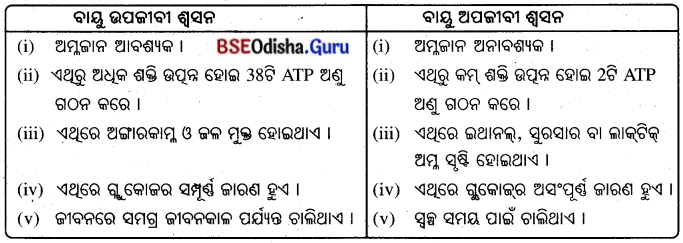
→ଜୀବଶ୍ବସନ :
- ଜୀବ ଗ୍ରହଣ କରୁଥିବା ଜୈବିକ ପୋଷକ ଶରୀରରେ ସରଳୀକୃତ ହୋଇ ପ୍ରତ୍ୟେକ କୋଷକୁ ଯାଇଥାଏ ।
- ମଣିଷ ଶରୀରରେ ଏହା ପାଚକ ପ୍ରଣାଳୀ ଓ ଉଭିଦ ଶରୀରର ପ୍ରତ୍ୟେକ କୋଷ ବା କେତେକ ନିର୍ଦ୍ଦିଷ୍ଟ କୋଷରେ ଏହି ଖାଦ୍ୟ ସରଳକରଣ ପ୍ରକ୍ରିୟା ଘଟିଥାଏ ।
- ଉଭିଦ ଓ ପ୍ରାଣୀ ଶରୀରରେ ହେଉଥିବା ବାୟୁ ଉପଜୀବୀ ଶ୍ୱସନ କ୍ରିୟାରେ ବ୍ୟବହୃତ ଅମ୍ଳଜାନର ଯୋଗାଣ ।
- ଜୀବ ପରିବେଶରୁ ଅମ୍ଳଜାନ ଗ୍ରହଣ କରିଥାଏ ।
- ଅମ୍ଳଜାନ ଗ୍ରହଣରେ ଉଭିଦ ଓ ପ୍ରାଣୀ ମଧ୍ୟରେ ଭିନ୍ନତା ଦେଖାଯାଏ ।
→ଉଭିଦ ଶ୍ବସନ :
- ଉଭିଦ ବିସରଣ ପ୍ରକ୍ରିୟାରେ ପରିବେଶରୁ ବାୟୁରେ ଥିବା ଅମ୍ଳଜାନ ଗ୍ରହଣ କରିଥାଏ ।
- ନିମ୍ନମାନର ପତ୍ରବିହୀନ ଉଭିଦ ନିଜ ଶରୀରର ଉପରିସ୍ଥ କୋଷ ମାଧ୍ୟମରେ ପରିବେଶରୁ ଅମ୍ଳଜାନଯୁକ୍ତ ବାୟୁ ସିଧାସଳଖ ବିସରଣଦ୍ୱାରା ଗ୍ରହଣ କରିଥାଏ ।
- ପତ୍ରଯୁକ୍ତ ସବୁଜ ଉଦ୍ଭିଦ ପତ୍ରରେ ରହିଥିବା ସ୍ତୋମ୍ ବା ଷ୍ଟୋମାଟା ମାଧ୍ୟମରେ ପରିବେଶରୁ ଅମ୍ଳଜାନ ଗ୍ରହଣ କରିଥାଏ ।
- ଦିନବେଳେ ଆଲୋକଶ୍ଳେଷଣ ସମୟରେ ପତ୍ର ଷ୍ଟେମାଟା ବାଟେ ଅଙ୍ଗାରକାମ୍ଳ ଗ୍ରହଣ କରେ ।
- ଏହି ସମୟରେ ଉଭିଦରେ କୋଷୀୟ ଶ୍ୱସନରେ ବାହାରୁଥିବା ଅଙ୍ଗାରକାମ୍ଳ ଆଲୋକଶ୍ଳେଷଣ ପ୍ରକ୍ରିୟାରେ ବ୍ୟବହୃତ ହୋଇଯାଏ ।
- ଆଲୋକଶ୍ଳେଷଣରେ ବାହାରୁଥିବା ଅମ୍ଳଜାନ ଶ୍ବସନ ପ୍ରକ୍ରିୟାରେ ବ୍ୟବହାର ହୁଏ । ଷ୍ଟେମାଟା ମାଧ୍ୟମରେ ଗୃହିତ ହୋଇଥିବା ଅମ୍ଳଜାନ ଗୋଟିଏ କୋଷରୁ ଅନ୍ୟ କୋଷକୁ ବିସରିତ ହୋଇ ଗଛର ଡାଳ, ପତ୍ର, ଫୁଲ, ଫଳ ଆଦି ଅଙ୍ଗରେ ରହିଥିବା ସମସ୍ତ କୋଷ ନିକଟରେ ପହଞ୍ଚିଥାଏ ।
→ପ୍ରାଣୀମାନଙ୍କ ଶ୍ବସନ :
- ଜଳଚର ପ୍ରାଣୀମାନଙ୍କ ମଧ୍ୟରେ ଶ୍ଵାସକ୍ରିୟା ସମ୍ପାଦନ ପାଇଁ ବିସରଣ ପ୍ରକ୍ରିୟା କାର୍ଯ୍ୟ କରେ ।
- ଏକକୋଷୀ, ଛିଦ୍ରାଳ ଓ ହାଇଡ୍ରାଜାତୀୟ ପ୍ରାଣୀର ଶ୍ଵାସକ୍ରିୟା ପାଇଁ ଜଳରେ ଦ୍ରବୀଭୂତ ଅମ୍ଳଜାନକୁ ସିଧାସଳଖ ବିସ୍ମରଣ ପ୍ରକ୍ରିୟାରେ ଗ୍ରହଣ କରିଥା’ନ୍ତି ।
- ଜିଆ, ଜୋକ ଓ ବେଙ୍ଗ ଚର୍ମଦ୍ଵାରା ଶ୍ଵାସକ୍ରିୟା କରିପାରନ୍ତି । ଓଦାଚର୍ମ ବାଟଦେଇ ବାୟୁମଣ୍ଡଳର ମୁକ୍ତ ଅମ୍ଳଜାନ ଦ୍ରବୀଭୂତ ହୋଇ ଶ୍ଵାସନରେ ବ୍ୟବହୃତ ହୁଏ ।
- ବେଙ୍ଗ ମୁଖଗହ୍ଵର ଓ ଫୁସ୍ଫୁସ୍ରା ମଧ୍ୟ ଶ୍ଵାସକ୍ରିୟା କରେ । ‘ଶୀତସୁପ୍ତି’ ସମୟରେ ବେଙ୍ଗ ଚର୍ମଦ୍ବାରା ହିଁ ଶ୍ଵାସକ୍ରିୟା
- ଅସରପା ପରି କୀଟପତଙ୍ଗମାନଙ୍କର ଶ୍ଵାସରନ୍ଧ୍ର ମଧ୍ୟଦେଇ ଅମ୍ଳଜାନ ଶରୀର ମଧ୍ୟକୁ ପ୍ରବେଶ କରେ ।
- କଙ୍କଡ଼ା, ଚିଙ୍ଗୁଡ଼ି, ଗେଣ୍ଡା, ଶାମୁକା ଗାଲିଦ୍ଵାରା ଶ୍ଵାସକ୍ରିୟା କରନ୍ତି ।
- ସାପ, ପାରା, ବତକ, ବାଦୁଡ଼ି, ମନୁଷ୍ୟ ଆଦି ପ୍ରାଣୀମାନଙ୍କ ଶ୍ଵାସକ୍ରିୟା ଫୁସ୍ଫୁସ୍ରା ହୋଇଥାଏ ।
- କଇଁଛ, କୁମ୍ଭୀର, ତିମି ପାଣିରେ ରହୁଥିଲେ ମଧ୍ୟ ଫୁସ୍ଫୁସ୍ଦ୍ୱାରା ଶ୍ଵାସକ୍ରିୟା କରନ୍ତି ।
- ବେଙ୍ଗର ଲାର୍ଭା ବା ଶୂକାବସ୍ଥା (ବେଙ୍ଗଫୁଲା) ଓ ମାଛ ଗାଲିଦ୍ୱାରା ଶ୍ଵାସକ୍ରିୟା କରିଥା’ନ୍ତି ।
![]()
→ଜୈବିକ ଜାରଣ (Biological oxidation) :
- ଅମ୍ଳଜାନ ଦହନର ସହାୟକ ଓ ଦହନ ସମୟରେ ତାପଶକ୍ତି ଉତ୍ପନ୍ନ ହୋଇଥାଏ । ଜୀବ ଶରୀରରେ ଏଭଳି ଦହନ ପ୍ରକ୍ରିୟାକୁ ଜୈବିକ ଜାରଣ କୁହାଯାଏ ।
- ଜୀବକୋଷରେ କୋଷଜୀବକ ଓ ମାଇଟୋକଣ୍ଡ୍ରିଆରେ ଜୈବିକ ଜାରଣ ପାଇଁ ଆବଶ୍ୟକ ଏନ୍ଜାଇମ୍ ରହିଥାଏ ।
- ଏଗୁଡ଼ିକର ସହଯୋଗରେ ଜୈବରାସାୟନିକ ପ୍ରକ୍ରିୟାଦ୍ବାରା ଖାଦ୍ୟରୁ ଶକ୍ତି ଉତ୍ପନ୍ନ ହୁଏ ଓ ଏହି ଶକ୍ତି ATP ଅଣୁରେ ବାନ୍ଧି ହୋଇ ରହିଥାଏ । ତେଣୁ ଜୀବକୋଷରେ ATP କୁ ଶକ୍ତିମୁଦ୍ରା ଓ ମାଇଟୋକଣ୍ଡ୍ରିଆକୁ ଶକ୍ତିକେନ୍ଦ୍ର କୁହାଯାଏ ।
- ଶ୍ଵାସନରେ ଉତ୍ପନ୍ନ ଶକ୍ତି ATP ଗଠନରେ ବ୍ୟବହୃତ ହୁଏ । ADPରେ ଗୋଟିଏ ଫସ୍ଫେଟ୍ ଅଣୁ (Pi) ମିଶିଲେ
 କୋଷର ବିଭିନ୍ନ ରାସାୟନିକ ପ୍ରକ୍ରିୟାରେ ATP ଭାଗନିଏ ।
କୋଷର ବିଭିନ୍ନ ରାସାୟନିକ ପ୍ରକ୍ରିୟାରେ ATP ଭାଗନିଏ । - ଗୋଟିଏ ATP ଅଣୁ ଭାଙ୍ଗି ADP ଓ Pi ରେ ପରିଣତ ହେଲେ 30.5 କିଲୋ ଜୁଲ୍ ଶକ୍ତି ନିର୍ଗତ ହୁଏ । ପେଶୀର ସଂକୋଚନ, ପୁଷ୍ଟିସାର ସଂଶ୍ଳେଷଣ, ସ୍ନାୟବିକ ଆବେଗ ସଞ୍ଚରଣ ଭଳି ସମସ୍ତ ପ୍ରକ୍ରିୟାରେ ATP ବ୍ୟବହୃତ ହୁଏ । ।
ଉଭିଦ ଓ ପ୍ରାଣୀଙ୍କ ଶ୍ଵାସକ୍ରିୟାରେ ପାର୍ଥକ୍ୟ : ଉଭିଦରେ ଷ୍ଟୋମାଟା ଦେଇ ଅମ୍ଳଜାନ ଓ ଅଙ୍ଗାରକାମ୍ଳ ଗ୍ୟାସ୍ ବିନିମୟ ହୁଏ, କିନ୍ତୁ ବିଭିନ୍ନ ପ୍ରାଣୀ ଶରୀରରେ ଏଥିପାଇଁ ଭିନ୍ନ ଭିନ୍ନ ଅଙ୍ଗ ରହିଛି ।
→ମଣିଷର ଶ୍ଵାସତନ୍ତ୍ର (Human Respiratory System) :
1.ମନୁଷ୍ୟ ଶରୀରରେ ଶ୍ୱାସତନ୍ତ୍ରର ବିଭିନ୍ନ ଅଂଶଗୁଡ଼ିକ ହେଉଛି ଯଥା- ନାସାରନ୍ଧ୍ର, ନାସାପଥ, ଗ୍ରସନୀ, ଶ୍ଵାସନଳୀ, ଶ୍ଵାସନଳିକା ଓ ଫୁସ୍ଫୁସ୍ ।
→ନାସାରନ୍ଧ୍ର (Nostril) :
- ପାଟି ଉପରେ ଓ ନାକର ନିମ୍ନଦେଶରେ ଶ୍ୱାସପଥର ଦ୍ଵାରଭାବେ ଦୁଇଟି ନାସାରନ୍ଧ୍ର (ନାକପୁଡ଼ା) ରହିଥାଏ ।
- ଏଠାରୁ ଶ୍ଵାସପଥ ଆରମ୍ଭ ହୋଇଥାଏ ଓ ଏହା ବାୟୁ ଗ୍ରହଣ ପାଇଁ ଉଦ୍ଦିଷ୍ଟ ।
- ନାକରନ୍ଧ୍ର ବା ନାକପୁଡ଼ା ଦୁଇଟିର ଅଗ୍ରଭାଗ ଉପାସ୍ଥିଦ୍ୱାରା ଗଠିତ ।
→ନାସାପଥ (Nasal cavity) :
- ଶ୍ଵାସ ପଥର ପ୍ର ଥମ ଭର ନାସାପଥ ନାମରେ ନାମିତ ଅଟେ ।
- ଏକ ଯୋଡ଼ା ନାସାପଥ ଉପାସ୍ଥି ନିର୍ମିତ ପଟିଦ୍ଵାରା ପରସ୍ପରଠାରୁ ଅଲଗା ହୋଇଥାଏ ।
- ବାହ୍ୟ ନାସାରନ୍ଧ୍ର ଦେଇ ବାହାରୁ ବାୟୁ ନାସାପଥ ମଧ୍ୟକୁ ପ୍ରବେଶ କରିଥାଏ । ନାସା ପଥ ଗ୍ର ସନୀ ପ୍ରବେଶ କରେ ।
- ଧୂଳି କଣା ଓ ଜୀବାଣୁ ଶ୍ଳେଷ୍ମକ ଝିଲ୍ଲୀରେ ଲାଗିଯାଆନ୍ତି ।

→ଗ୍ରସନୀ (Pharynx) :
- ଗ୍ରସନୀ ଏକ ପେଶୀବହୁଳ ନଳୀ ଓ ହୋଇ ଶ୍ଵାସନଳୀ ଓ ଖାଦ୍ୟନଳୀର ଏହା ନାସାପଥର ଶେଷଠାରୁ ଆରମ୍ଭ ଆରମ୍ଭ ପର୍ଯ୍ୟନ୍ତ ରହିଥାଏ ।
- ନାସାପଥ ନିକଟରେ ଥିବା ଗ୍ରସନୀର ଅଂଶକୁ ନାସା-ଗ୍ରସନୀ ଏବଂ ମୁଖଗହ୍ଵର ନିକଟରେ ଥିବା ଅଂଶକୁ ମୁଖ- ଗ୍ରସନୀ କୁହାଯାଏ ।
- ଗ୍ରସନୀର ପଛ କାନ୍ଥରେ ଏକଯୋଡ଼ା ଟନ୍ସିଲ୍ ରହିଥାଏ । ଏହା ଏକ ଲସିକାଭ ଅଙ୍ଗ ଅଟେ ।
- ଗ୍ରସନୀର ଶେଷଭାଗରୁ ଖାଦ୍ୟନଳୀ ଓ ଶ୍ଵାସନଳୀ ଆରମ୍ଭ ହୋଇଥାଏ । ଶ୍ଵାସନଳୀର ଦ୍ୱାରକୁ ଗ୍ଲଟିସ୍ ଓ ଖାଦ୍ୟନଳୀର ଦ୍ଵାରକୁ ଗଲେଟ୍ କୁହାଯାଏ ।
- ଶ୍ଵାସନଳୀର ଦ୍ଵାର ଅଧ୍ୱଜିହ୍ଵା ନାମକ ଏକ ପରଦାଦ୍ଵାରା ବନ୍ଦରହେ । କିନ୍ତୁ ଖାଦ୍ୟନଳୀର ଦ୍ଵାରରେ କୌଣସି ପ୍ରକାର କପାଟିକା ନଥାଏ ।
- ଖାଦ୍ୟ ଗିଳିବା ସମୟରେ ଶ୍ଵାସନଳୀର ଦ୍ବାର ଅଧ୍ୱଜିହ୍ବାଦ୍ଵାରା ବନ୍ଦ ରହୁଥିବାରୁ ଖାଦ୍ୟ ଶ୍ଵାସନଳୀ ମଧ୍ଯରେ ପ୍ରବେଶ କରିପାରେ ନାହିଁ ।
- ଅନ୍ୟ ସମୟରେ ଶ୍ଵାସନଳୀର ଦ୍ଵାର ଖୋଲା ରହୁଥିବାରୁ ସାଧାରଣ ଭାବେ ଶ୍ଵାସକ୍ରିୟା ସମ୍ପାଦିତ ହୋଇଥାଏ ।
→ଶ୍ଵାସନଳୀ (Trachea) :
1.ଶ୍ଵାସନଳୀର ଆରମ୍ଭରେ ସ୍ୱରପେଟିକା ରହିଥାଏ ।
2.ଏଥିରେ ଥିବା ସରୁ ସରୁ ସୂତା ପରି ସ୍ଵରତନ୍ତ୍ରୀ ବା ଭୋକାଲ କର୍ଡ଼ର କମ୍ପନଦ୍ୱାରା ଧ୍ଵନି ସୃଷ୍ଟି ହୁଏ ।
3.ଶ୍ଵାସନଳୀ ଦୁଇ ବ୍ରୋକାଇ ଭାବେ ବିଭକ୍ତ ହୋଇ ପ୍ରତ୍ୟେକ ନିଜ ପଟର ଫୁସ୍ଫୁସ୍ ମଧ୍ୟକୁ ପ୍ରବେଶ କରିଥା’ନ୍ତି ।
ପରେ ପ୍ରତ୍ୟେକ ପଟର ବ୍ରେନ୍କସ୍ ଅନେକ ଶାଖା ପ୍ରଶାଖାରେ ବିଭକ୍ତ ହୋଇ ଶ୍ଵାସନଳିକା ସୃଷ୍ଟି କରିଥାଏ ଓ ପ୍ରତ୍ୟେକ ଶ୍ଵାସନଳିକା କୋଟରିକାକୁ ଖୋଲିଥାଏ ।
ଫୁସ୍ଫୁସ୍ ଚାରିପଟେ ରହିଥାଏ ପ୍ଲରାଲ୍ କେଭିଟି । ଏହା ବାହ୍ୟ ଓ ଆଭ୍ୟନ୍ତରୀଣ ଆବରଣକୁ ନେଇ ଗଠିତ । ଭିତର ପଟର ଆବରଣଟି ଫୁସ୍ଫୁସ୍କୁ ଆବୃତ କରି ରଖୁବାବେଳେ ବାହ୍ୟ ଆବରଣଟି ବକ୍ଷଗହ୍ଵର ଓ ମଧ୍ୟଚ୍ଛଦାର ଭିତର ପଟକୁ ଲାଗିକରି ରହିଥାଏ । ଗହ୍ଵର ଭିତରେ ଥିବା ରସ ଆବରଣ ଦୁଇଟିକୁ ପିଛିଳ କରି ରଖିଥାଏ । ଏହି ବାୟୁରୋଧୀ ଗହ୍ଵରର ଚାପ ଫୁସ୍ଫୁସ୍ଠାରୁ ପ୍ରାୟ 3-4mm Hg କମ୍ ଥାଏ । ଏହା ପ୍ରଶ୍ଵାସବେଳେ କୋଟରିକାମାନଙ୍କ ଭିତରେ ବାୟୁ ଭର୍ତ୍ତି ହେବାରେ ସାହାଯ୍ୟ କରେ ।
→ଫୁସଫୁସ (Lungs) :
- ବକ୍ଷଗହ୍ଵର ମଧ୍ୟରେ ଦୁଇଟି ଫୁସ୍ଫୁସ୍ ରହିଥାଏ । ଏହା ହେଉଛି ଦକ୍ଷିଣ ଓ ବାମ ଫୁସ୍ଫୁସ୍ ।
- ଏହା ସ୍ପଞ୍ଜ ପରି ନରମ ଅଟେ । ଏହା ଫୁସ୍ଫୁସ୍ ଆବରଣଦ୍ବାରା ଆଚ୍ଛାଦିତ ହୋଇ ରହିଥାଏ ।
- ଫୁସ୍ଫୁସ୍ ଧମନୀଦ୍ୱାରା ହୃତ୍ପିଣ୍ଡରୁ ଅଙ୍ଗାରକାମ୍ଳଯୁକ୍ତ ରକ୍ତ ଫୁସ୍ଫୁସ୍କୁ ଆସିଥାଏ ଏବଂ ଫୁସ୍ଫୁସ୍ରୁ ଅମ୍ଳଜାନଯୁକ୍ତ ରକ୍ତ ଫୁସ୍ଫୁସ୍ ଶିରା ଦେଇ ହୃତ୍ପିଣ୍ଡକୁ ଫେରିଥାଏ ।
→ଶ୍ଵାସକ୍ରିୟା (Respiration) :
ଏହା ତିନୋଟି ପର୍ଯ୍ୟାୟରେ ହୋଇଥାଏ; ଯଥା-
- ସଂବାତନ,
- ଗ୍ୟାସ୍ ବିନିମୟ,
- ଗ୍ୟାସ୍ ପରିବହନ ।
→ସଂବାତନ (Ventilation)
- ସଂବାତନ ଦୁଇ ପର୍ଯ୍ୟାୟବିଶିଷ୍ଟ ଅଟେ; ଯଥା- ପ୍ରଶ୍ଵାସ ଓ ନିଃଶ୍ଵାସ ।
- ଫୁସ୍ଫୁସ୍ ମଧ୍ୟକୁ ବାୟୁର ପ୍ରବେଶକୁ ପ୍ରଶ୍ଵାସ ଓ ଫୁସ୍ଫୁସ୍ରୁ ବାୟୁର ପ୍ରସ୍ଥାନକୁ ନିଃଶ୍ଵାସ କୁହାଯାଏ ।
- ଜଣେ ସୁସ୍ଥ ବ୍ୟକ୍ତିରେ ଏହି ପ୍ରଶ୍ଵାସ ଓ ନିଃଶ୍ଵାସ ହାର ମିନିଟ୍କୁ ପ୍ରାୟ 15 ରୁ 20 ଥର ଅଟେ ।
- ବୃକ୍ଷଗହ୍ଵର ଏକ ଫମ୍ପା ପବନ-ନିରୋଧୀ କୋଠରୀ ଅଟେ । ଏହାର ଆଗପଟ ଷ୍ଟର୍ନମ୍ ଦ୍ଵାରା, ପଛପଟ
- ମେରୁଦଣ୍ଡଦ୍ୱାରା, ଦୁଇପଟ ପଞ୍ଜରା ହାଡ଼ ଓ ଅନ୍ତଃ-ପଞ୍ଜରା ମାଂସପେଶୀଦ୍ଵାରା ଏବଂ ତଳପଟ ମଧ୍ୟଚ୍ଛଦାଦ୍ଵାରା ଆବଦ୍ଧ ହୋଇ ରହିଥାଏ ।
- ମଧ୍ୟଚ୍ଛଦା ଏକ ଗମ୍ବୁଜ ଆକାରର, ପେଶୀବହୁଳ ପଟ୍ଟ ଅଟେ । ଏହା ଆମର ବକ୍ଷଗହ୍ଵର ଏବଂ ଉଦରଗହ୍ବରକୁ ପୃଥକ୍ କରିରଖୁଥାଏ ।
→ପ୍ରଶ୍ଵାସ (Inspiration) :
- ଫୁସ୍ଫୁସ୍ ମଧ୍ୟକୁ ବାୟୁର ପ୍ରବେଶକୁ ପ୍ରଶ୍ଵାସ କୁହାଯାଏ ।
- ଶ୍ଵାସକ୍ରିୟା ସମୟରେ ଅନ୍ତଃପଞ୍ଜରା ମାଂସପେଶୀ, ମଧ୍ୟଚ୍ଛଦା ଓ ଉଦରୀୟ ମାଂସପେଶୀ’ ସକ୍ରିୟ ଅଂଶଗ୍ରହଣ ନରିଥନନ୍ତି
- ପ୍ରଶ୍ଵାସ ସମୟରେ ଅନ୍ତଃପଞ୍ଜରା ମାଂସପେଶୀର ସଂକୋଚନ ଓ ଉଦରୀୟ ମାଂସପେଶୀର ଶିଙ୍ଖଳନ ଘଟିଥାଏ । ଫଳସ୍ବରୂପ ଗମ୍ବୁଜାକାର ମଧ୍ଧଚ୍ଛଦା ସଳଖ ବା ସମତଳ ହୋଇଥାଏ ଓ ପଞ୍ଜରାହାଡ଼ ଆଗକୁ ଉଠିଆସେ ।
- ଏହି ପ୍ରକ୍ରିୟା ସମୟରେ ବକ୍ଷଗହ୍ଵରର ଆୟତନ ପ୍ରାୟ 20% ବୃଦ୍ଧିପାଏ ଏବଂ ବକ୍ଷଗହ୍ଵର ଓ ଫୁସ୍ଫୁସ୍ ମଧ୍ୟସ୍ଥ ଥିବା ଫୁସ୍ଫୁସ୍ ମଧ୍ୟକୁ ପ୍ରବେଶ କରେ । ଏହା ଏକ ସକ୍ରିୟ ପ୍ରକ୍ରିୟା ଅଟେ ।
![]()
→ନିଃଶ୍ଵାସ (Expiration):
- ଫୁସ୍ଫୁସ୍ରୁ ବାୟୁର ପ୍ରସ୍ଥାନକୁ ନିଃଶ୍ଵାସ କୁହାଯାଏ ।
- ଏହା ଏକ ଶିଥୁଳନ ପ୍ରକ୍ରିୟା ଅଟେ । ଏହି ସମୟରେ ମଧ୍ୟଚ୍ଛଦା ଓ ଅନ୍ତଃପଞ୍ଜରା ମାଂସପେଶୀର ଶିଥୁନ ଘଟିବା ସହ ଉଦରୀୟ ମାଂସପେଶୀର ସଂକୋଚନ ଘଟିଥାଏ ।
- ପଞ୍ଜରା ହାଡ଼ ପୂର୍ବ ସ୍ଥାନକୁ ଫେରି ଆସେ ଓ ମଧ୍ୟଚ୍ଛଦା ପୁଣି ଗମ୍ବୁଜାକାର ହୋଇଥାଏ ।
- ବକ୍ଷଗହ୍ବରର ଆକାର ହ୍ରାସ ପାଏ ଓ ଏହା ଫୁସ୍ଫୁସ୍ ଉପରେ ଚାପ ପକାଏ, ତେଣୁ ଫୁସ୍ଫୁସ୍ ମଧ୍ୟରୁ ବାୟୁ ବାହାରକୁ ଚ।ଲଆପୋ
→ଗ୍ୟାସ୍ ବିନିମୟ (Gaseous Exchange) :
1. ଫୁସ୍ଫୁସ୍ ମଧ୍ୟକୁ ବାୟୁ ପ୍ରବେଶ କଲାପରେ ଏଥିରେ ଥିବା କୋଟରିକାଗୁଡ଼ିକ ବାୟୁଦ୍ୱାରା ପୂର୍ଣ୍ଣ ହୁଏ । ସାଧାରଣତଃ ବାହାର ବାୟୁରେ ଅମ୍ଳଜାନର ସାନ୍ଦ୍ରତା ଅଧୂକ ଓ ଅଙ୍ଗାରକାମ୍ଳର ସାନ୍ଦ୍ରତା କମ୍ ରହିଥାଏ ।
2. ଏହି ସମୟରେ କୋଟରିକାକୁ ଘେରି ରହିଥିବା ରକ୍ତଜାଲକ ମଧ୍ୟରେ ପ୍ରବାହିତ ହେଉଥିବା ରକ୍ତରେ ଅମ୍ଳଜାନର ସାନ୍ଦ୍ରତା କମ୍ ଓ ଅଙ୍ଗାରକାମ୍ଳର ସାନ୍ଦ୍ରତା ଅଧିକ ରହିଥାଏ ।
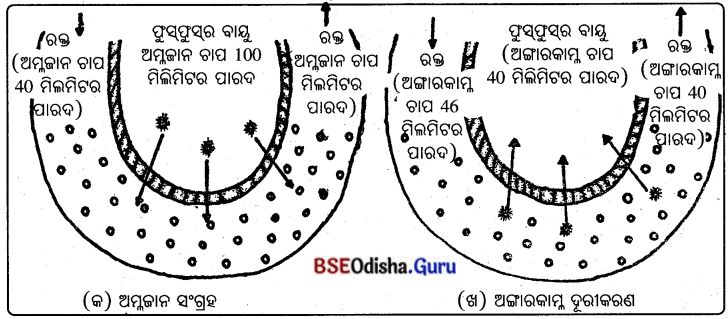 3. କୋଟରିକା ମଧ୍ୟରେ ଥିବା ଠ, ଓ CO2 ଗ୍ୟାସ୍ ଓ ରକ୍ତଜାଲକ ମଧ୍ୟରେ ଥିବା ଠ, ଓ CO2 ଗ୍ୟାସ୍ ମଧ୍ୟରେ ସାନ୍ଦ୍ରତାରେ ଭିନ୍ନତା ଥାଏ । ଏଥ୍ଗୁଁ କୋଟରିକା ମଧ୍ୟସ୍ଥ ବାୟୁ ଓ ରକ୍ତଜାଲକରେ ପ୍ରବାହିତ ରକ୍ତ ମଧ୍ୟରେ ବିସରଣ ପ୍ରକ୍ରିୟା ଦ୍ବାରା ଅମ୍ଳଜାନ ଓ ଅଙ୍ଗାରକାମ୍ଳ ଗ୍ୟାସ୍ତ୍ରର ବିନିମୟ ଘଟିଥାଏ ।
3. କୋଟରିକା ମଧ୍ୟରେ ଥିବା ଠ, ଓ CO2 ଗ୍ୟାସ୍ ଓ ରକ୍ତଜାଲକ ମଧ୍ୟରେ ଥିବା ଠ, ଓ CO2 ଗ୍ୟାସ୍ ମଧ୍ୟରେ ସାନ୍ଦ୍ରତାରେ ଭିନ୍ନତା ଥାଏ । ଏଥ୍ଗୁଁ କୋଟରିକା ମଧ୍ୟସ୍ଥ ବାୟୁ ଓ ରକ୍ତଜାଲକରେ ପ୍ରବାହିତ ରକ୍ତ ମଧ୍ୟରେ ବିସରଣ ପ୍ରକ୍ରିୟା ଦ୍ବାରା ଅମ୍ଳଜାନ ଓ ଅଙ୍ଗାରକାମ୍ଳ ଗ୍ୟାସ୍ତ୍ରର ବିନିମୟ ଘଟିଥାଏ ।
4. ଅମ୍ଳଜାନ, ଫୁସ୍ଫୁସ୍ କୋଟରିକାରୁ ରକ୍ତ ମଧ୍ୟକୁ ପ୍ରବେଶ କରେ ଓ ରକ୍ତମଧ୍ୟରୁ ଅଙ୍ଗାରକାମ୍ଳ ଗ୍ୟାସ୍ ଫୁସ୍ଫୁସ୍ କୋଟରିକା ମଧ୍ୟକୁ ବାହାରି ଆସେ ।
→ଗ୍ୟାସ ପରିବହନ Gas transportation) :
- ରକ୍ତର ଲୋହିତ କଣିକା (RBC)ରେ ହିମୋଗ୍ଲୋବିନ୍ ଥାଏ । ଏହା ଅମ୍ଳଜାନ ଗ୍ରହଣକରି ଅକ୍ସିହିମୋଗ୍ଲୋବିନ୍ରେ ପରିଣତ ହୁଏ । ଅକ୍ସିହିମୋଗ୍ଲୋବିନ୍ ରକ୍ତ ମାଧ୍ୟମରେ ଶରୀରର ପ୍ରତ୍ୟେକ କୋଷ ନିକଟରେ ପହଞ୍ଚିଥାଏ ।
- କୋଷ ନିକଟରେ ଅକ୍ସିହିମୋଗ୍ଲୋବିନ୍ ଭାଙ୍ଗି ଅମ୍ଳଜାନ ଓ ହିମୋଗ୍ଲୋବିନ୍ ସୃଷ୍ଟିହୁଏ । ଏହି ଅମ୍ଳଜାନ କୋଷମାନଙ୍କ ମଧ୍ୟକୁ ପ୍ରବେଶ କରେ ଏବଂ କୋଷମାନଙ୍କରୁ ନିର୍ଗତ ଅଙ୍ଗାରକାମ୍ଳ ଗ୍ୟାସ୍ ରକ୍ତକୁ ଚାଲିଆସେ ।
- କୋଷସ୍ତରରେ ଘଟୁଥିବା ଏହି ଗ୍ୟାସୀୟ ବିନିମୟ ମଧ୍ୟ ବିସରଣ ପ୍ରକ୍ରିୟାଦ୍ଵାରା ହୋଇଥାଏ । କୋଷରୁ ନିର୍ଗତ ଅଙ୍ଗାରକାମ୍ଳ ଗ୍ୟାସ୍ ରକ୍ତ ମାଧ୍ୟମରେ ଫୁସ୍ଫୁସ୍ରେ ପହଞ୍ଚେ ଓ ବିସରଣ ପ୍ରକ୍ରିୟା ଦ୍ୱାରା ରକ୍ତରୁ ଫୁସ୍ଫୁସ୍ କୋଟରିକା ବାଟ ଦେଇ ବାୟୁମଣ୍ଡଳକୁ ନିର୍ଗତ ହୋଇଥାଏ ।



